Andrew Wireless System M17P17P17P ION-M17P/17P/17P RF Repeater User Manual M0132AKA FCC
Andrew Wireless System ION-M17P/17P/17P RF Repeater M0132AKA FCC
Users Manual
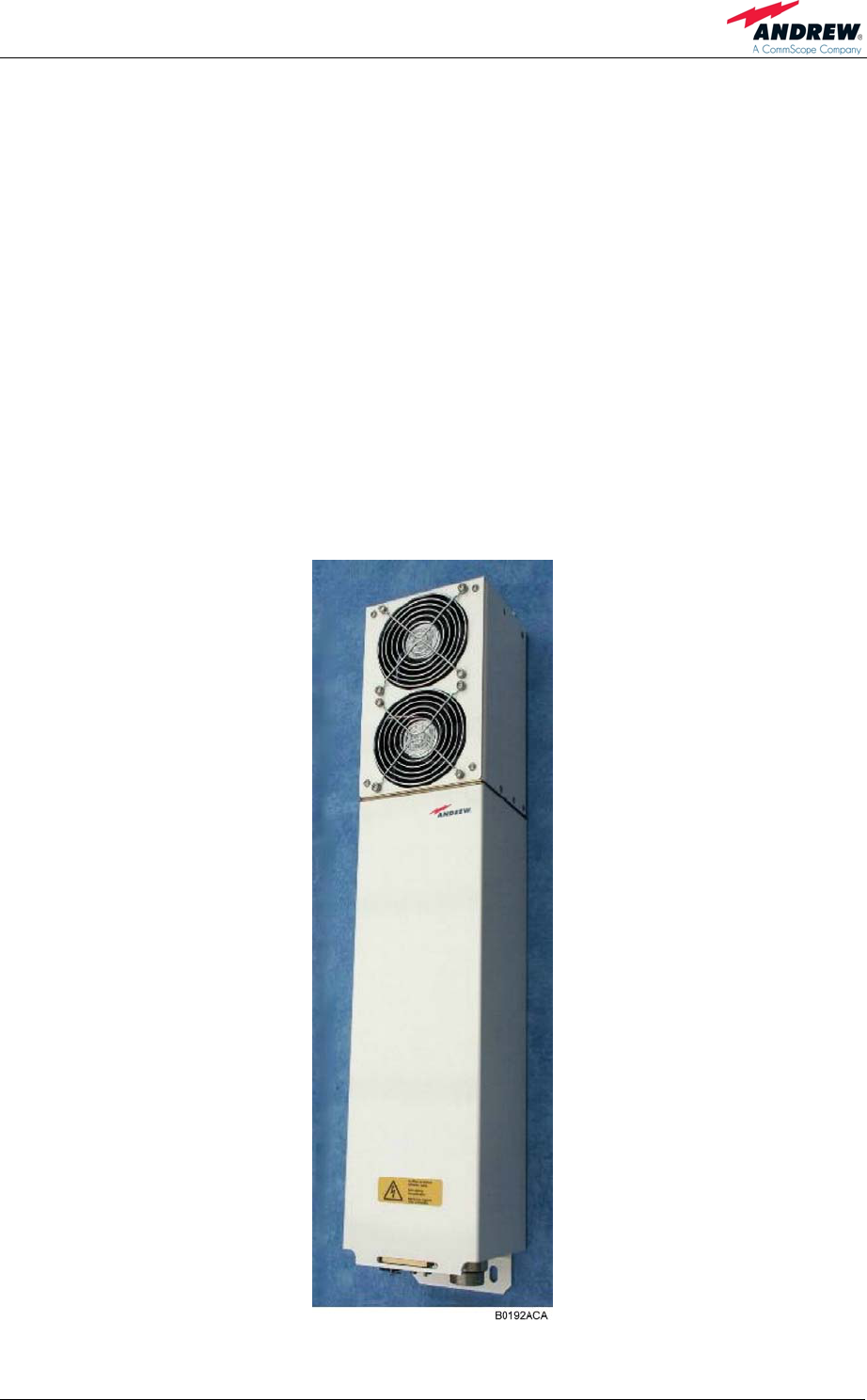
M0132AKA_FCC.doc
User’s Manual
for
Optical Remote Unit
ION™-M 17P/17P/17P

User’s Manual for Remote Unit
ION-M17P/17P/17P
Page 2 M0132AKA_FCC.doc
© Copyright 2009 CommScope, Inc.
All rights reserved.
Andrew Solutions is a trademark of CommScope, Inc.
All information contained in this manual has been revised thoroughly. Yet Andrew
Solutions accepts no liability for any omissions or faults.
Andrew Solutions reserves the right to change all hard- and software characteristics
without notice.
Names of products mentioned herein are used for identification purposes only and
may be trademarks and / or registered trademarks of their respective companies.
No parts of this publication may be reproduced, stored in a retrieval system,
transmitted in any form or by any means, electronical, mechanical photocopying,
recording or otherwise, without prior written permission of the publisher.
Andrew Wireless Systems GmbH, 24-June-2009

Page 3
TABLE OF CONTENTS
1 GENERAL 7
1.1 USED ABBREVIATIONS 7
1.2 HEALTH AND SAFETY WARNINGS 9
1.3 ABOUT ANDREW SOLUTIONS 11
1.4 INTERNATIONAL CONTACT ADDRESSES 12
2 INTRODUCTION 13
2.1 PURPOSE 13
2.2 ION-M17P/17P/17P 13
3 FUNCTIONAL DESCRIPTION 15
3.1 GENERAL 15
3.2 COMPONENTS OF THE ION-M17P/17P/17P REMOTE UNIT 16
3.2.1 Components Inside the Unit 16
3.2.2 Fan-Protection Kit 17
3.2.3 Accessories 17
4 COMMISSIONING 19
4.1 MECHANICAL INSTALLATION 19
4.1.1 General 19
4.1.2 Wall-Mounting Procedure 21
4.1.3 Pole-Mounting Procedure 22
4.1.4 Mounting of Fan Protection 24
4.2 ELECTRICAL INSTALLATION 25
4.2.1 General 25
4.2.2 Connections 26
4.2.3 Grounding 27
4.2.4 Connection of the Antenna Cables 28
4.2.5 Power Connection 29
4.3 OPTICAL-FIBRE-CABLE CONNECTION - RULES 30
4.3.1 Protective Plug 31
4.3.2 Protective-Tube Kit 33
4.4 COMMISSIONING 35

User’s Manual for Remote Unit
ION-M17P/17P/17P
Page 4 M0132AKA_FCC.doc
5 ALARMS 39
5.1 BITE AND ALARMS 39
5.2 HANDLING OF ALARMS 39
5.3 ALARM STATUS 39
5.4 STATUS LED ALARMS 39
5.5 EXTERNAL ALARM INPUTS AND OUTPUTS 41
5.6 TROUBLESHOOTING 42
6 MAINTENANCE 43
6.1 GENERAL 43
6.2 REPLACING THE FAN UNIT 44
6.3 CLEANING THE HEAT SINK 46
7 APPENDIX 47
7.1 ILLUSTRATIONS 47
7.2 SPECIFICATIONS 48
7.2.1 Electrical Specifications 48
7.2.2 Environmental and Safety Specifications 49
7.2.3 Mechanical Specifications 49
7.3 SPARE PARTS 50
8 INDEX 51

Page 5
FIGURES AND TABLES
figure 3-1 Configuration of an ION-M17P/17P/17P remote unit................................ 15
figure 3-2 Remote unit, front view, fully RF equipped ............................................... 16
figure 3-3 Remote unit, backside, fully RF equipped ................................................ 16
figure 4-1 Wall mounting........................................................................................... 21
figure 4-2 Pole-mounting kit...................................................................................... 22
figure 4-3 Pole mounting .......................................................................................... 23
figure 4-4 Mounting procedure for fan protection...................................................... 24
figure 4-5 Connector flange of ION-M17P/17P/17P.................................................. 26
figure 4-6 RS232 connector...................................................................................... 27
figure 4-7 Grounding bolt with loosened hex nut ...................................................... 27
figure 4-8 Grounding bolt, schematic view................................................................ 27
figure 4-9 AC mains plug .......................................................................................... 29
figure 4-10 DC mains plug........................................................................................ 29
figure 4-11 Protective-plug assembly ....................................................................... 31
figure 4-12 Tube-kit installation................................................................................. 34
figure 5-1 Alarm triggering ........................................................................................ 40
figure 5-2 Flange connector, 5 poles ........................................................................ 41
figure 5-3 Flange connector, 7 poles ........................................................................ 41
figure 5-4 Alarm inputs and outputs, standard .......................................................... 42
figure 7-1 Installation drawing................................................................................... 47
table 1-1 List of international contact addresses 12
table 4-1 Specified torques 20
table 4-2 RS232 connector, pin assignment 27
table 5-1 Status LED alarms 40

User’s Manual for Remote Unit
ION-M17P/17P/17P
Page 6 M0132AKA_FCC.doc
For your notes:

1 General
Page 7
1 GENERAL
1.1 USED ABBREVIATIONS
ALC Automatic Level Control
AMPS American Mobile Phone System or Advanced Mobile Phone System
APAC Automatic Power Adjustment Circuit
AWS Advanced Wireless Services
BCCH Broadcast Control Channel
BITE Built-In Test Equipment
BTS Base Transceiver Station
CDMA Code Division Multiple Access
CEPT Conférénce Européenne des Postes et Télécommunications
CF Center Frequency
CFO Center Frequency Offset
CPD Channel Power Detection
DL Downlink
EDGE Enhanced Data Rates for GSM Evolution
ESD Electrostatic Discharge
ETS European Telecommunication Standard
ETSI European Telecommunication Standards Institute
FCC Federal Communications Commission
FSK Frequency Shift Keying
GSM Global System for Mobile Communication
GUI Graphical User Interface
I2C-Bus Inter Integrated Circuit Bus (Philips)
ID No Identification Number
IF Intermediate Frequency
LMT Local Maintenance Terminal
MS Mobile Station
NSO Network Supervision Option
OMC Operation and Maintenance Center
PCMCIA Personal Computer Modem Communication International Association
PCS Personal Communication System
PSTN Public Switched Telephone Network
Rev Revision
RF Radio Frequency
RLP Radio Link Protocol
RSSI Receive Signal Strength Indication
RTC Real-Time Clock
RX Receiver
SCL Serial Clock
SDA Serial Data
SISO Single Input Single Output
SPD Switching Point Detector
TCH Traffic Channel
TDD Time-Division Duplex
TDMA Time Division Multiple Access
TX Transmitter

User’s Manual for Remote Unit
ION-M17P/17P/17P
Page 8 M0132AKA_FCC.doc
UL Uplink
UMR Universal Measurement Receiver
UMTS Universal Mobile Telecommunication System
UPS Uninterruptible Power Supply
VSWR Voltage Standing Wave Ratio
WDM Wavelength Division Multiplex
WiMAX Worldwide Interoperability for Microwave Access
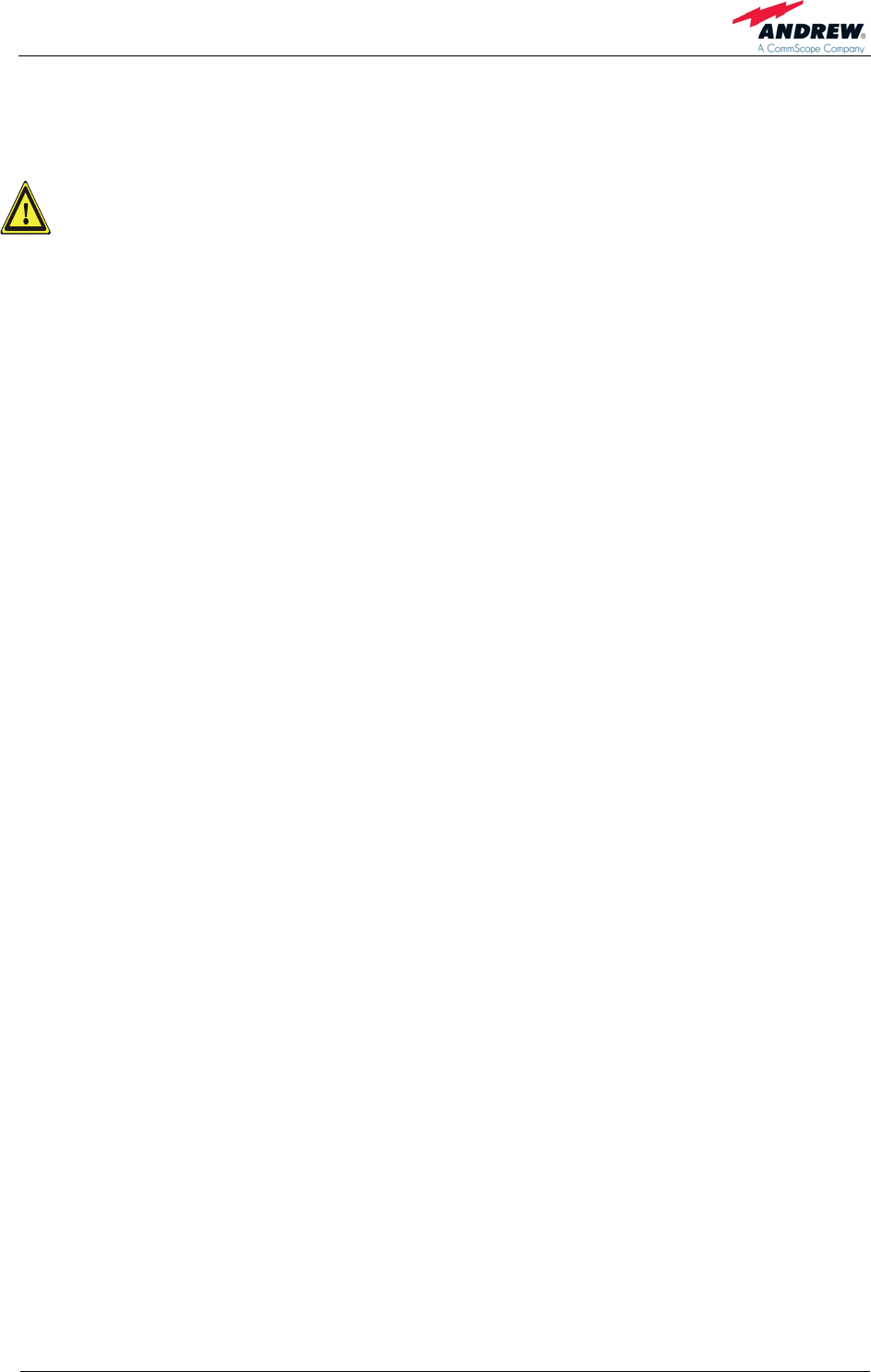
1 General
Page 9
1.2 HEALTH AND SAFETY WARNINGS
1. Only suitably qualified personnel is allowed to work on this unit and only after
becoming familiar with all safety notices, installation, operation and maintenance
procedures contained in this manual.
2. Read and obey all the warning labels attached to the unit. Make sure that the
warning labels are kept in a legible condition and replace any missing or
damaged labels.
3. Obey all general and regional installation and safety regulations relating to work
on high voltage installations, as well as regulations covering correct use of tools
and personal protective equipment.
4. Keep operating instructions within easy reach and make them available to all
users.
5. It is the responsibility of the network provider to implement prevention measures
to avoid health hazards which may be associated to radiation from the antenna(s)
connected to the unit.
6. For US and Canadian installations: To comply with FCC RF exposure compliance
requirements, the following antenna installation and device operating
configurations must be satisfied: A separation distance of at least 4 m must be
maintained between the antenna of this device and all persons. RF exposure
compliance may need to be addressed at the time of licensing, as required by the
responsible FCC Bureau(s), including antenna co-location requirements of
1.1307(b)(3). Maximum permissible antenna gain is 17 dBi.
7. Make sure access is restricted to qualified personnel.
8. Only licence holders for the respective frequency range are allowed to operate
this unit.
9. Use this equipment only for the purpose specified by the manufacturer. Do not
carry out any modifications or fit any spare parts which are not sold or
recommended by the manufacturer. This could cause fires, electric shock or other
injuries.
10. Due to power dissipation, the remote unit may reach a very high temperature. Do
not operate this equipment on or close to flammable materials.
11. Before opening the unit or (dis-)connecting the mains connector at the remote
unit, ensure that mains supply is disconnected.
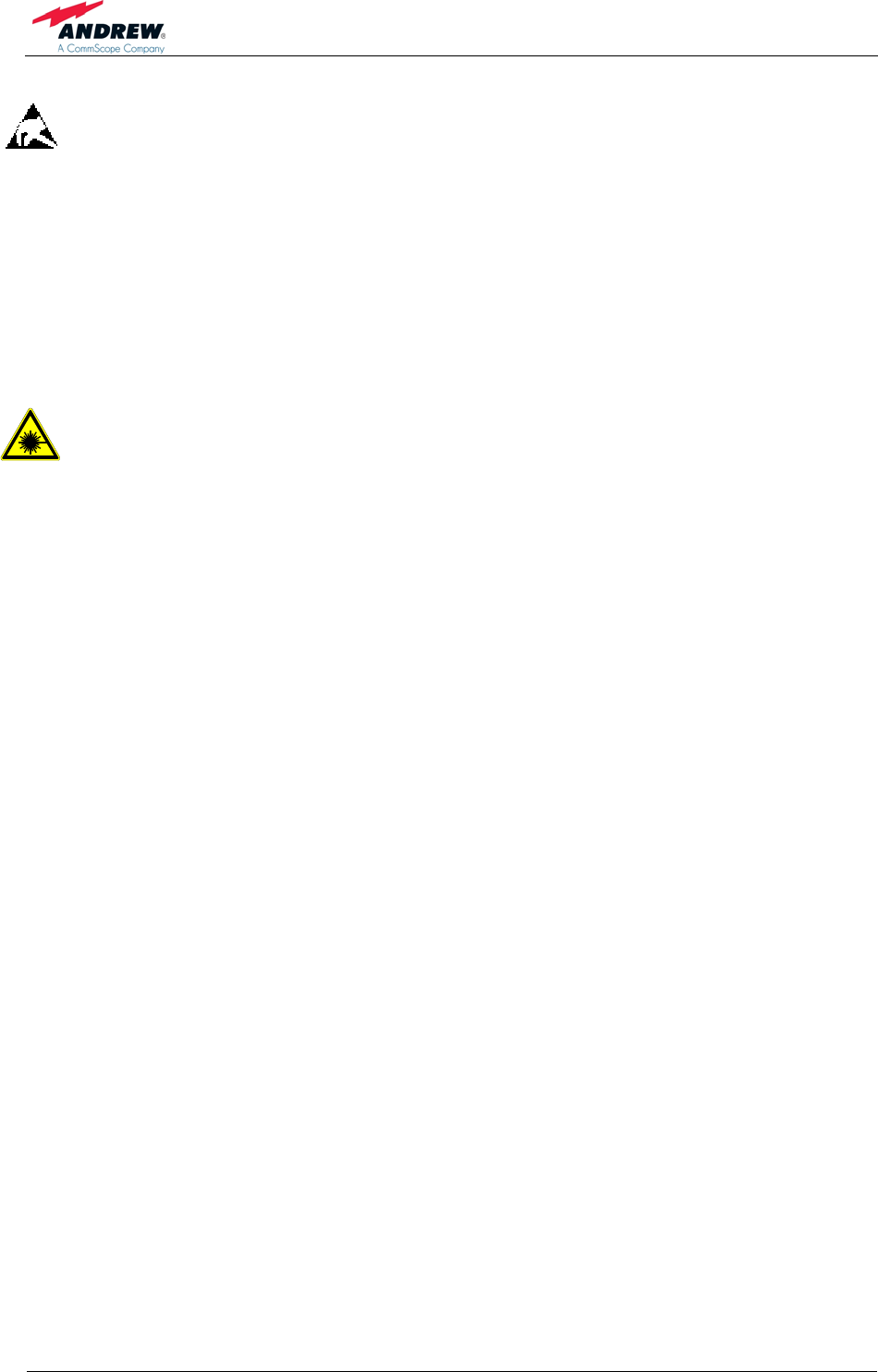
User’s Manual for Remote Unit
ION-M17P/17P/17P
Page 10 M0132AKA_FCC.doc
12. ESD precautions must be observed! Before commencing maintenance work, use
the available grounding system to connect ESD protection measures.
13. This unit complies with European standard EN60950.
14. Make sure the system settings are according to the intended use (see also
product information of manufacturer) and regulatory requirements are met.
15. Although the remote unit is internally protected against overvoltage, it is strongly
recommended to earth the antenna cables close to the antenna connectors of the
remote unit for protection against atmospheric discharge.
16. Laser radiation – Class 1! Do not stare into the beam; do not view it directly or
with optical instruments.

1 General
Page 11
1.3 ABOUT ANDREW SOLUTIONS
Andrew Solutions is a leading manufacturer of coverage equipment for mobile radio
networks, specializing in low cost, high performance, RF and optical repeaters. Our
optical distributed networks and RF repeater systems provide coverage for every
application: outdoor use, indoor installations, tunnels, subways and many more.
Andrew Solutions has engineering and manufacturing facilities in Germany, Italy and
the USA. In addition, it maintains field engineering offices throughout the world.
Andrew Wireless Systems GmbH operates a quality management system which
complies with the requirements of ISO 9001. All equipment is manufactured using
highly reliable material. In order to ensure constant first-rate quality of the products,
comprehensive quality monitoring is conducted at all fabrication stages. Finished
products leave the factory only after a thorough final acceptance test, accompanied
by a test certificate guaranteeing optimal operation.
The declaration of conformity for the product is available upon request from the local
offices or from Andrew Solutions directly.
Any intervention must be carried out by authorized persons only.
For technical assistance, contact the local office or Andrew Solutions directly at one
of the following addresses:
Andrew Wireless Systems GmbH
Industriering 10
86675 Buchdorf
Germany
Phone: +49 9099 69-0
Fax: +49 9099 69-930
E-mail: WIsupport.germany@andrew.com
for The Americas:
Wireless Innovations Group
Andrew A CommScope Company
Phone: +1 888 297 6433
E-mail: WIsupport.us@andrew.com
When set-up is performed according to this manual, the system will operate without
complications for a significant length of time.

User’s Manual for Remote Unit
ION-M17P/17P/17P
Page 12 M0132AKA_FCC.doc
1.4 INTERNATIONAL CONTACT ADDRESSES
Australia Austria Brazil
6 Stuart Street
Padstow NSW 2211
Australia
Weglgasse 10
Wien-Schwechat 2320
Austria
Av Com Camilo Julio 1256
Predio B
Zonal Industrial CP 597
Sorocaba SP 18086-000
Brazil
Phone +61 2 9774-4200 Phone +43 1706 3999-10 Phone +55 15 2102-4000
Fax +61 2 9774-4500 Fax +43 1706 3999-9 Fax +55 15 2102-4001
E-mail E-mail E-mail
WIsupport.australia@andrew.com WIsupport.austria@andrew.com WIsupport.brazil@andrew.com
Canada China Czech Republic
606 Beech St W
Whitby ON L1N 5S2
Canada
RM 915 Chevalier
Commercial Centre
8 Wang Hoi Rd
Kowloon Bay SAR
Hong Kong
U Moruší 888
Pardubice
53006
Czech Republic
Phone +1 905 668-3348 Phone +852 3106 6100 Phone +420 46 63012-80
Fax +1 905 668-8590 Fax +852 2751 7800 Fax +420 46 63012-98
E-mail E-mail E-mail
WIsupport.canada@andrew.com WIsupport.china@andrew.com WIsupport.czechrep@andrew.com
France Italy Spain and Portugal
28 Rue Fresnel
Z.A Pariwest
BP 182
Coignières cedex 78313
France
Via de Crescenzi 40
Faenza 48018
Italy
C/ Salvatierra
5. Pta 3
28034 Madrid
Spain
Phone +33 1 300-54550 Phone +39 0546 697111 Phone +34 91 745 20 40
Fax +33 1 346-11374 Fax +39 0546 682768 Fax +34 91 564 29 85
E-mail E-mail E-mail
WIsupport.france@andrew.com WIsupport.italy@andrew.com WIsupport.iberia@andrew.com
Switzerland UK U.S.A.
Tiergartenweg 1
4710 Balsthal CH-4710
Switzerland
Ilex Bldg Mulberry Business
Park
Fishponds Rd
Wokingham Berkshire
England RG41 2Gy
620 North Greenfield Parkway
Garner, NC 27529
United States
Phone +41 62 386-1260 Phone +44 118 936-6700 Phone +1 919 329-8700
Fax +41 62 386-1261 Fax +44 118 936-6773 Fax +1 919 329-8950
E-mail E-mail E-mail
WIsupport.switzerland@andrew.com WIsupport.uk@andrew.com WIsupport.us@andrew.com
table 1-1 List of international contact addresses

2 Introduction
Page 13
2 INTRODUCTION
2.1 PURPOSE
Cellular telephone systems transmit signals in two directions between base
transceiver station (BTS) and mobile stations (MS) within the signal coverage area.
If weak signal transmissions occur within the coverage area because of indoor
applications, topological conditions or distance from the transmitter, extension of the
transmission range can be achieved by means of an optical distribution system.
Such a system contains an optical master unit and several remote units. The number
of the remote units depends on the hardware and software configuration. The remote
units are connected to the master unit with optical links. The optical loss must be less
than 10 dB inclusive optical couplers or splitters.
The master unit is the connection to the base transceiver stations. The configuration
of a master unit depends on the number of the remote units and the frequency range.
The optical transmission uses WDM-systems with a wavelength of 1550 nm in the
Uplink and 1310 nm in the Downlink.
2.2 ION-M17P/17P/17P
Andrew Solutions ION-M17P/17P/17P is a 3 sector single-box remote unit. It is used
in conjunction with a master unit in the ION optical distribution system. This system
transports 3 sectors (3 x 1700/2100 MHz) simultaneously, providing a cost-effective
solution for distributing capacity from one or more base stations.
The ION-M17P/17P/17P transports signals on the RF layer in a very inexpensive
manner. This means that multiple operators and multiple technologies are moved
simultaneously from a cluster of base stations to a remote location over the same
fibre.
The ION optical distribution system is a cost-effective coverage solution for dense
urban areas, airports, high-rise buildings and other locations where physical
structures increase path loss or provide limited space for installation. It has been
specifically designed to reduce zoning problems and to provide homogeneous
coverage. The compact, mechanical design is specifically architected to mount inside
of or on poles and along side structures in such a way that it has a minimal visual
impact.
The ION-M platform has been specifically tested and optimized for CDMA2000.
Furthermore it is provisioned for future improvements to the modulation and
frequency bands.

User’s Manual for Remote Unit
ION-M17P/17P/17P
Page 14 M0132AKA_FCC.doc
The ION is easily set-up and supervised via a graphical user interface (GUI). Remote
units can be commissioned through the use of built-in test equipment. An auto-
levelling function compensates for the optical link loss making installation easy and
quick.
The entire system may be monitored remotely via an Andrew OMC. This is a
comprehensive management platform with SNMP protocol and X.733 standard
implemented. Should a sophisticated interface not be required, the master unit can
be directly connected to the alarm interface of a base station via relay alarming.
• 3 sector multi-operator support
• Reduced visual impact form factor
• Efficient, high power amplifier
• Single fibre for multiple sectors
• Comprehensive operations and management system for configuration and
alarming
• OMC with SNMP according to X.733 standard
• Easy installation and commissioning
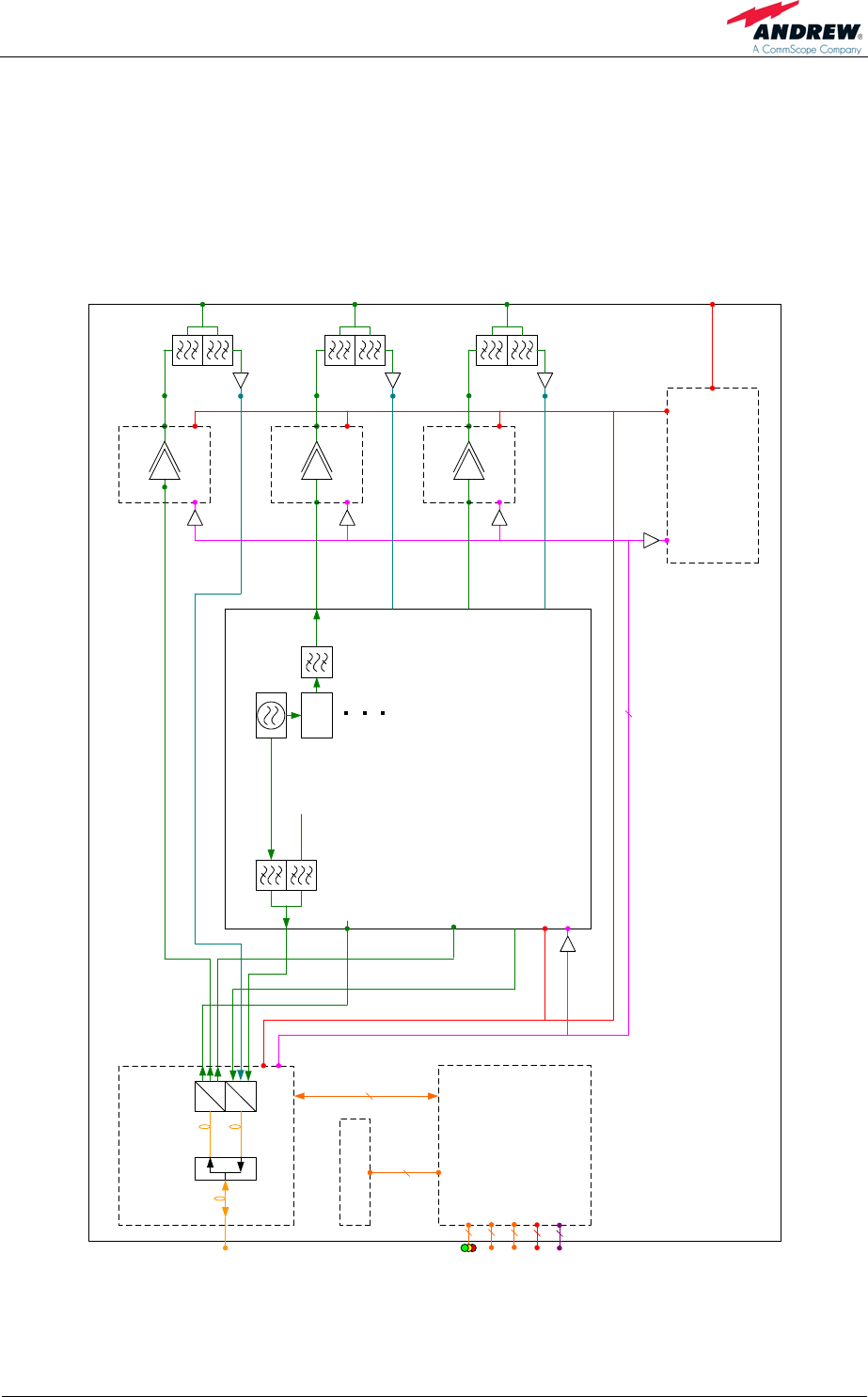
3 Functional Description
Page 15
3 FUNCTIONAL DESCRIPTION
3.1 GENERAL
The following figure shows the configuration of an ION-M17P/17P/17P remote unit.
o
e
o
e
DL
UL
UL/DL
WDM OTRX
from / to Master Unit
Optical Module
Control Unit RCM161
X11
X3
3
3 colors LED
X12
4 external alarms
inputs
X12
4 external alarms
outputs
X12+28 VDC output
Power Amplifier
Sector 1
LNA
DPX
Duplexer Unit
Power Supply Unit
Mains
+28 VDCI²C
+28 VDCI²C
RF + DC
100 - 240 VAC
5
5
3
X6
Fan
5
Active Cooling Kit 4442
2
+28 VDC
I²C
X12RS232 3
Power Amplifier 2
I²C +28 VDC
Power Amplifier 3
+28 VDCI²C
DPX
DPX
LNA
LNA
RF + DC
RF + DC
Sector 2
Sector 3
+
Frequency Management
Buffer
Buffer
Buffer
Buffer
Buffer
figure 3-1 Configuration of an ION-M17P/17P/17P remote unit
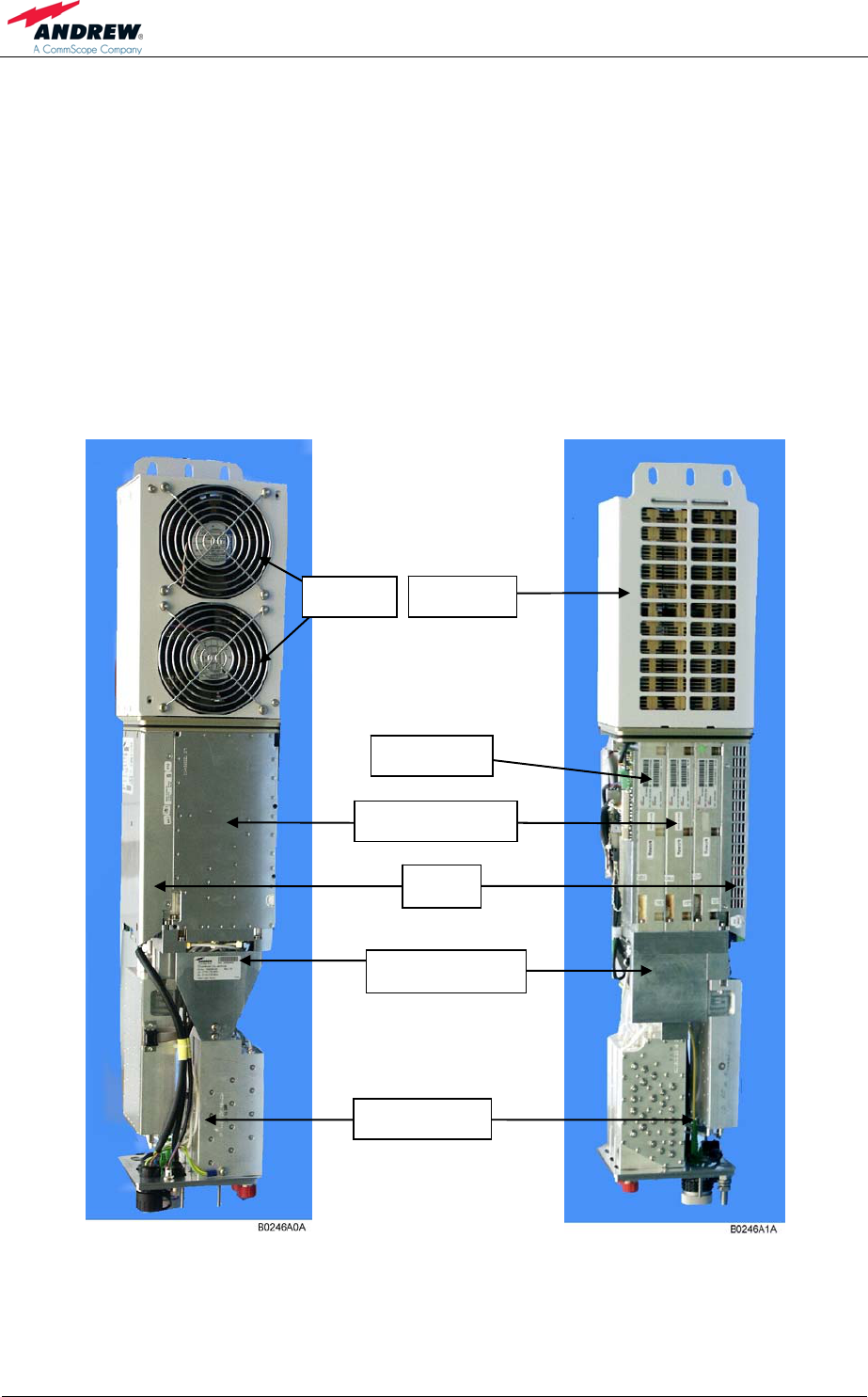
User’s Manual for Remote Unit
ION-M17P/17P/17P
Page 16 M0132AKA_FCC.doc
3.2 COMPONENTS OF THE ION-M17P/17P/17P REMOTE UNIT
The actual configuration of the remote unit can be seen at the configuration list which
is part of the delivery.
3.2.1 Components Inside the Unit
The following figures show exemplary views of a fully equipped ION-M17P/17P/17P
remote unit – except for the fan housing without cover – to illustrate the individual
components.
figure 3-2 Remote unit, front view,
fully RF equipped
figure 3-3 Remote unit, backside,
fully RF equipped
Air inlet Air outlet
PSU
Distribution unit
Duplexer
Optical module
Amplifiers

3 Functional Description
Page 17
3.2.2 Fan-Protection Kit
In order to protect the fan unit (e.g. against rain), a protective cover to be mounted
over the air inlet is delivered with the unit. For indoor applications, mounting of the
fan-protection kit is not mandatory.
For more details see chapter 4.1.4 Mounting of Fan Protection.
3.2.3 Accessories
For the accessories available for the remote unit, e.g. overcoat housing, connecting
box or iso-trafo kit, a separate manual is available.

User’s Manual for Remote Unit
ION-M17P/17P/17P
Page 18 M0132AKA_FCC.doc
For your notes:
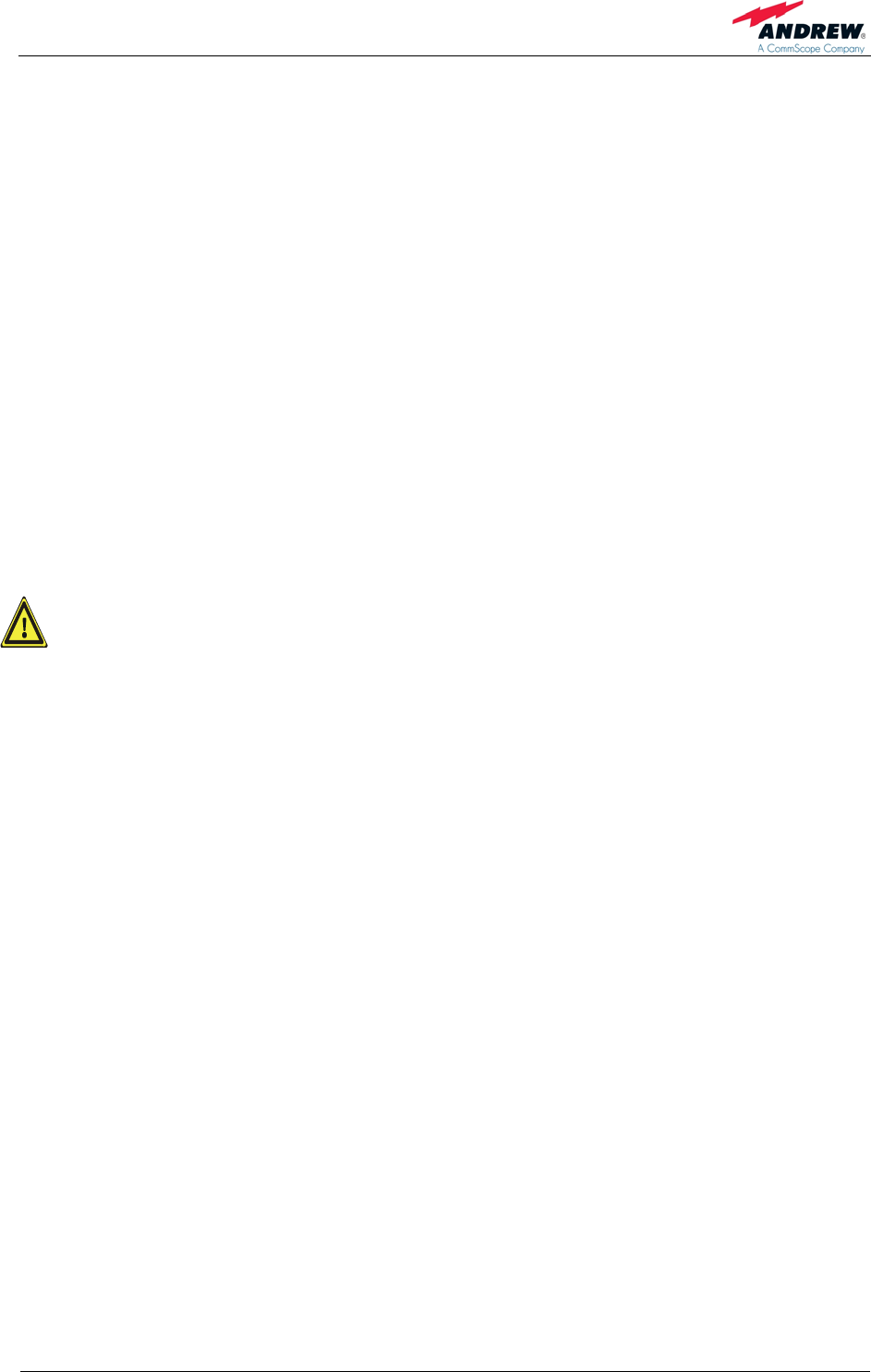
4 Commissioning
Page 19
4 COMMISSIONING
4.1 MECHANICAL INSTALLATION
4.1.1 General
Read the health and safety warnings in chapter 1.2 Health and Safety Warnings.
1. Do not install the unit in a way or at a place where the specifications
outlined in the Environmental and Safety Specifications leaflet of the
supplier are not met.
2. It is recommended only to use the mounting hardware delivered by the
supplier. If different mounting hardware is used, the specifications for
stationary use of the remote unit must not be exceeded.
) Note: Exceeding the specified load limits may cause the loss of warranty!
3. The unit is considerably heavy. Make sure that a suitable mounting surface
is used. Ensure there is adequate manpower to handle the weight of the
system.
4. Due to power dissipation, the remote unit may reach a very high
temperature. Ensure sufficient airflow for ventilation as specified in the
individual mounting procedures.
5. When connecting and mounting the cables (RF, optical, mains, ...) ensure
no water can penetrate into the unit through these cables.
6. Also observe all additional rules or restrictions regarding mounting that
depend on the type of remote unit. For details refer to chapter 7.2.3
Mechanical Specifications. It is strongly recommended to install the unit
vertically with the fan unit at the top. If horizontal mounting is required, the
fan unit must also be at the top and a tilt angle of at least 10° from a
horizontal position must be kept.
7. A spacing of 40 mm (1.58 inch) around the unit is required.
8. To ensure sufficient airflow when mounting the unit in enclosed spaces, two
lid openings (one for the air inlet and the other for the air outlet) have to be
provided. Do not block these air inlets and outlets when mounting the
remote unit. The size of each opening must equal at least 12 x 12 cm (144
cm2). Make sure, too, there is no thermal short circuit between the air inlet
and air outlet.
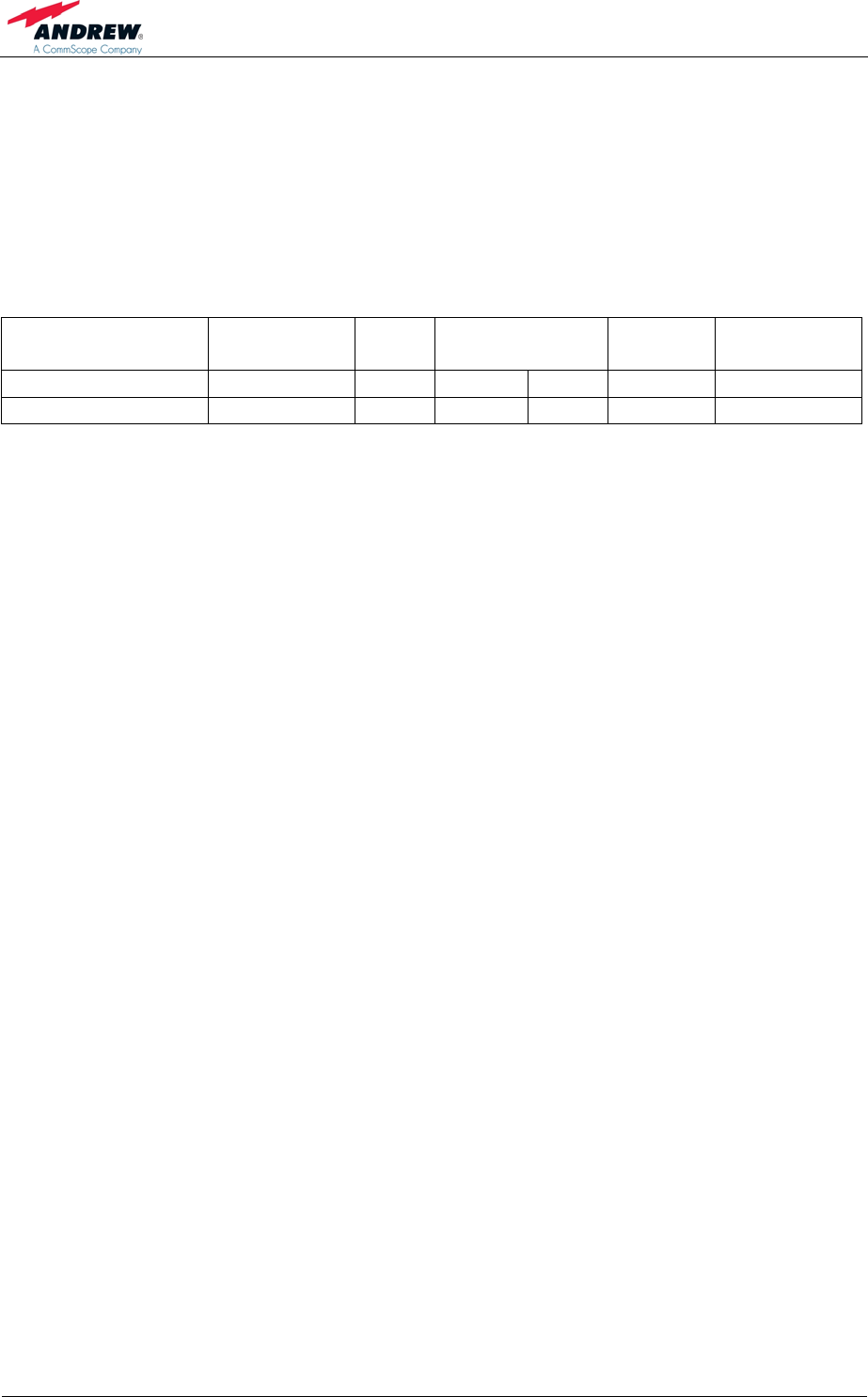
User’s Manual for Remote Unit
ION-M17P/17P/17P
Page 20 M0132AKA_FCC.doc
If any different or additional mounting material is used, ensure that the mounting
remains as safe as the mounting designed by the manufacturer. Ensure that the
static and dynamic strengths are adequate for the environmental conditions of the
site. The mounting itself must not vibrate, swing or move in any way that might cause
damage to the remote unit.
Specified torques have to be observed for certain mounting procedures according to
the following table:
Type Tallow-drop
screws
Hex
nuts
Spacing
bolts
PG
(plastic)
PG
(aluminium)
Thread M 4 M 8 M 4 M 8 PG 13.5 PG 29
Specified torques 3.3 Nm 27 Nm 2.3 Nm 27 Nm 3.75 Nm 10 Nm
table 4-1 Specified torques
) Note: To avoid damage when mounting the unit, always make sure that
the M8 washers (DIN9021 or DIN125 depending on the mounting kit)
are placed behind and in front of the mounting drillings of the unit.
The mounting procedures for a stand-alone remote unit without optional accessories
are described and illustrated in the following sections. For further information
regarding special mounting procedures including mounting of accessory equipment,
please see separate manual.
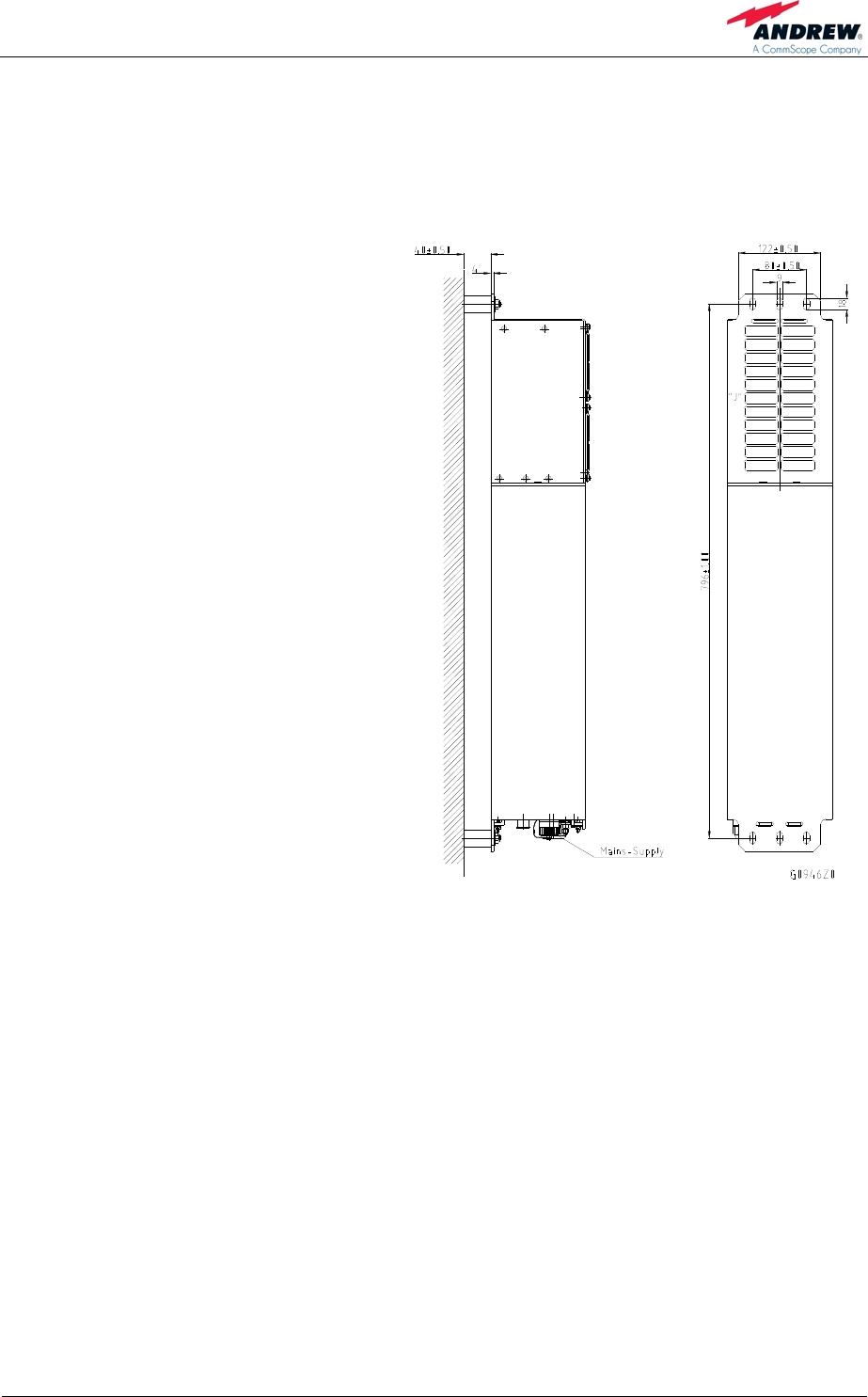
4 Commissioning
Page 21
4.1.2 Wall-Mounting Procedure
• Check the suitability of the wall-mounting kit and the wall.
• Mark the position of the drilling
holes (for measurements refer to
figure 4-1 Wall mounting). Drill
four holes at the marked positions
and insert dowels*.
• Use a cap nut or lock nut to screw
the four dowel screws into the
dowels and put the distance tubes
over the screws.
• Hang the mounting brackets of the
remote unit into the screws, and
fasten them immediately using the
washers and nuts.
• Ensure that there is free access to
the electrical connections as well
as to the cabinet. The approved
bending radius of the connected
cables must not be exceeded.
figure 4-1 Wall mounting
* The dowels are not part of the delivery since the suitable type depends on the on-site conditions
(material of wall). Therefore, use dowels that are appropriate for the mounting surface.
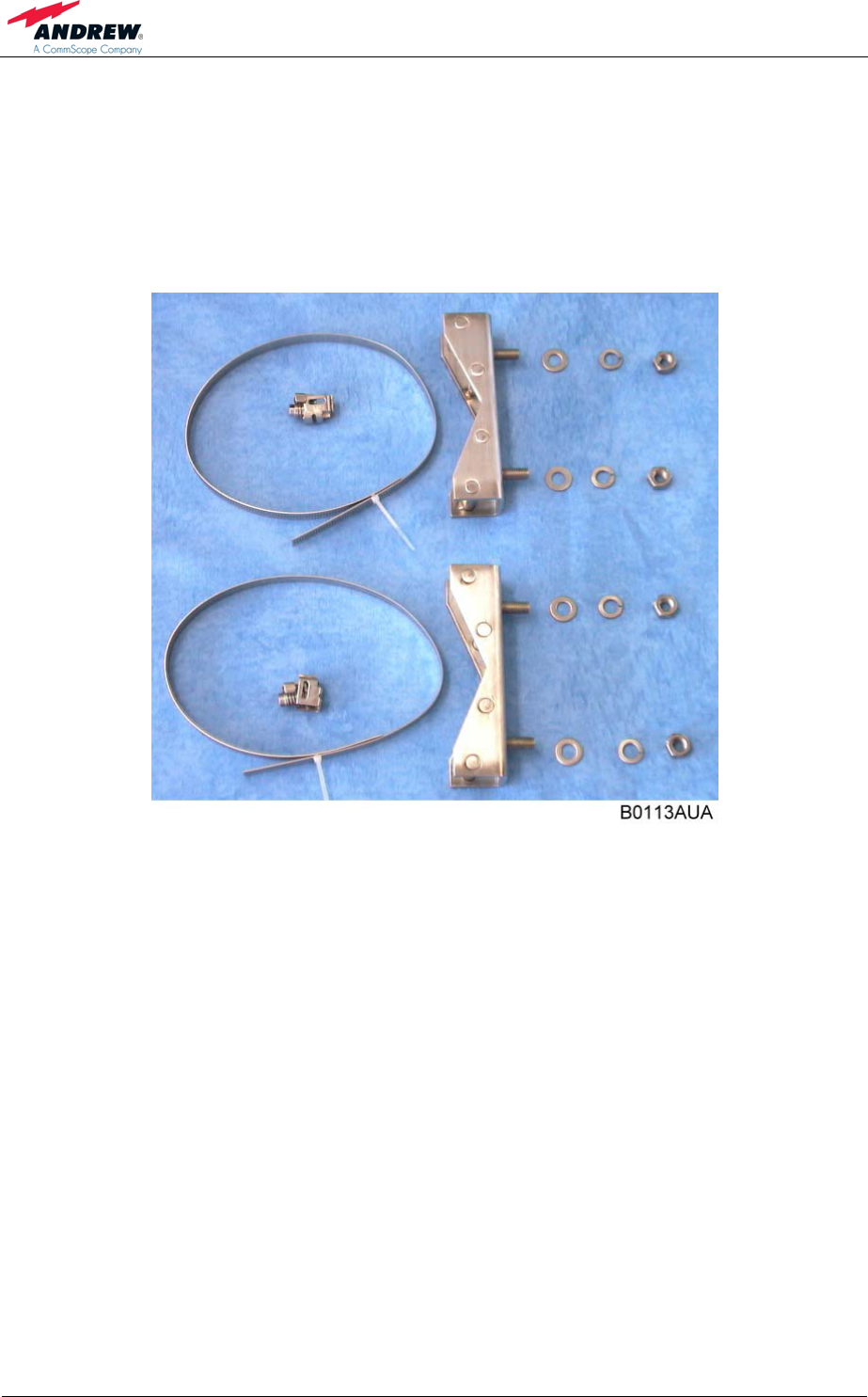
User’s Manual for Remote Unit
ION-M17P/17P/17P
Page 22 M0132AKA_FCC.doc
4.1.3 Pole-Mounting Procedure
Standard mounting hardware cannot be used to mount the remote unit to a pole, a
column or other similar structures. Additional hardware must be used for this type of
installation. Such a pole-mounting kit could include two threaded rods M8, two
U-beams and mounting material like bolts and nuts.
figure 4-2 Pole-mounting kit
• Use the screw bands to fasten the two U-beams to the pole as illustrated in figure
4-3 Pole mounting
) Note: When fastening the U-beams make sure that they are installed
congruently and not at an angle to each other. To determine the
distance between the beams refer to 4.1.2 Wall-Mounting Procedure
for measurements.
• Hang the mounting brackets of the remote unit into the threaded bolts of the
U-beam, and fasten them immediately using the washers and nuts.
Ensure that there is free access to the electrical connections as well as to the
cabinet. The approved bending radius of the connected cables must not be
exceeded.
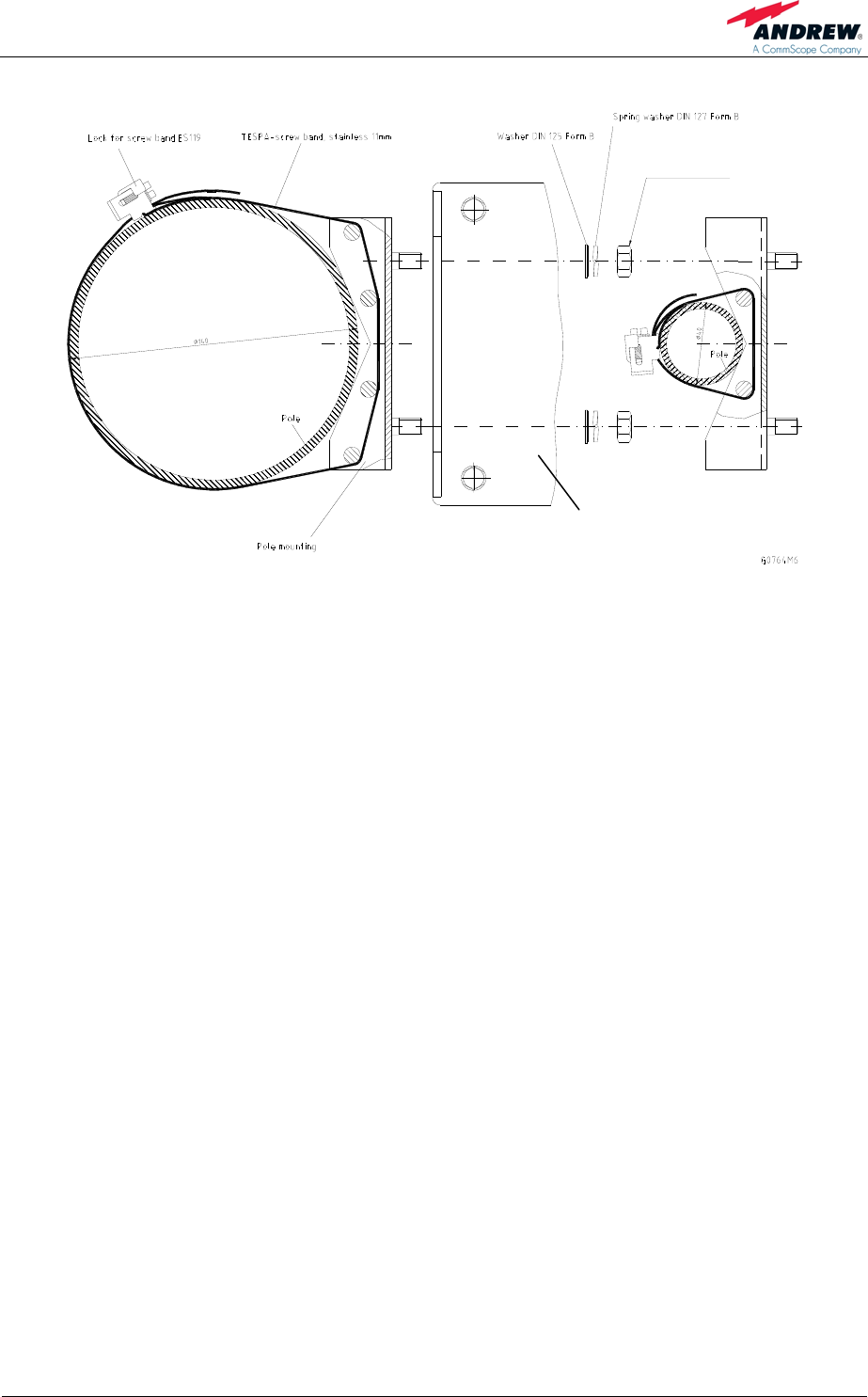
4 Commissioning
Page 23
Nut M8 DIN 934
figure 4-3 Pole mounting
Optical remote unit
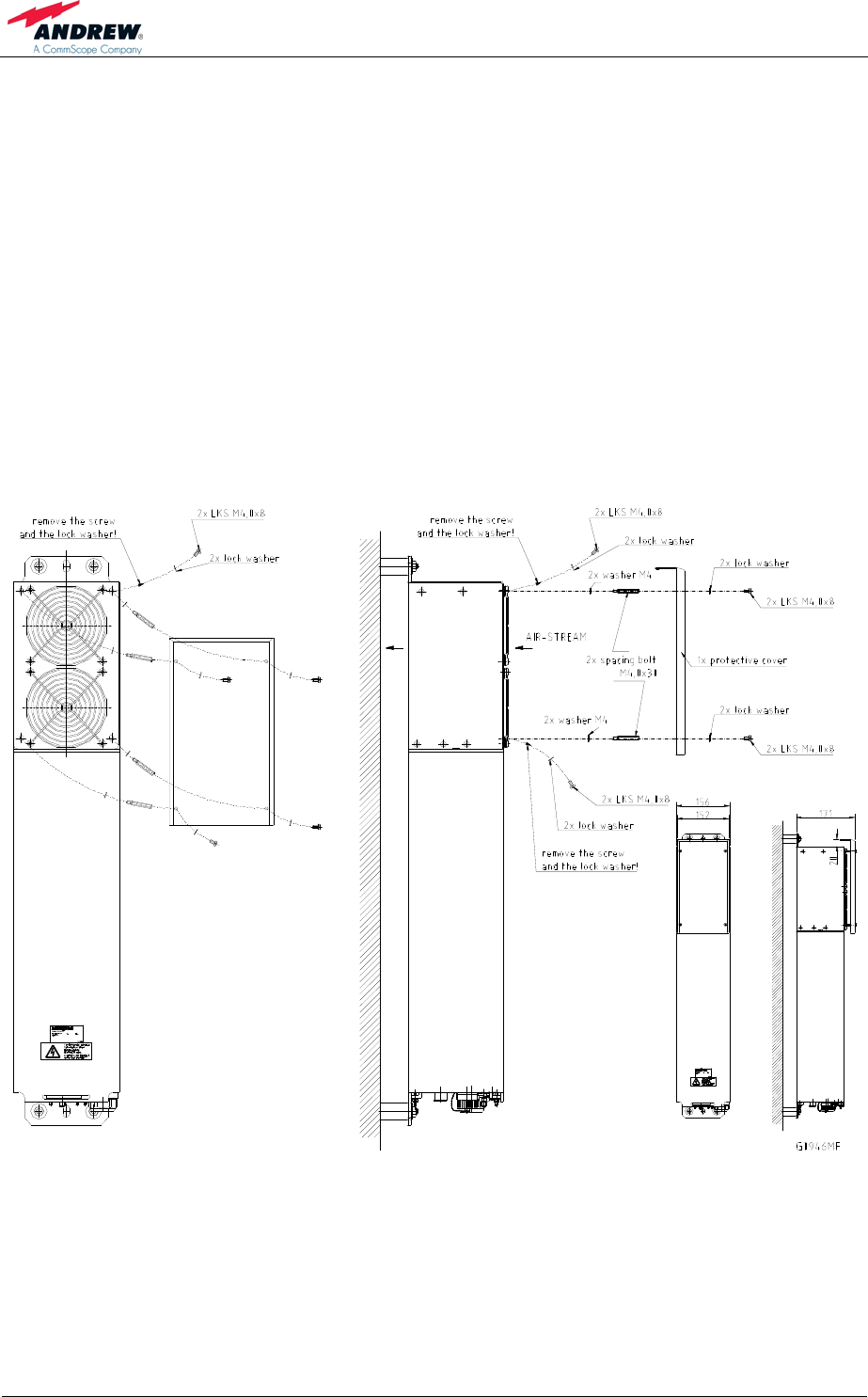
User’s Manual for Remote Unit
ION-M17P/17P/17P
Page 24 M0132AKA_FCC.doc
4.1.4 Mounting of Fan Protection
Since the fan protection is required for the outdoor usage of a stand-alone remote
unit, the mounting of this optional equipment is also described in this manual.
• To install the protective cover of the fan protection kit, first unscrew the four
screws with the respective lock washers from the cover of the air inlet of the
remote unit, and instead, screw in the four spacing bolts M4.0x30 with the four
lock washers M4.0 DIN125 that are part of the fan protection kit.
• Place the protective cover into the right position by fitting its four bore holes over
the spacing bolts and fasten it using the original lock washers and screws of the
remote unit. (These lock washers and screws are also part of the fan protection
kit and can be used as spare parts in case of loss.)
figure 4-4 Mounting procedure for fan protection
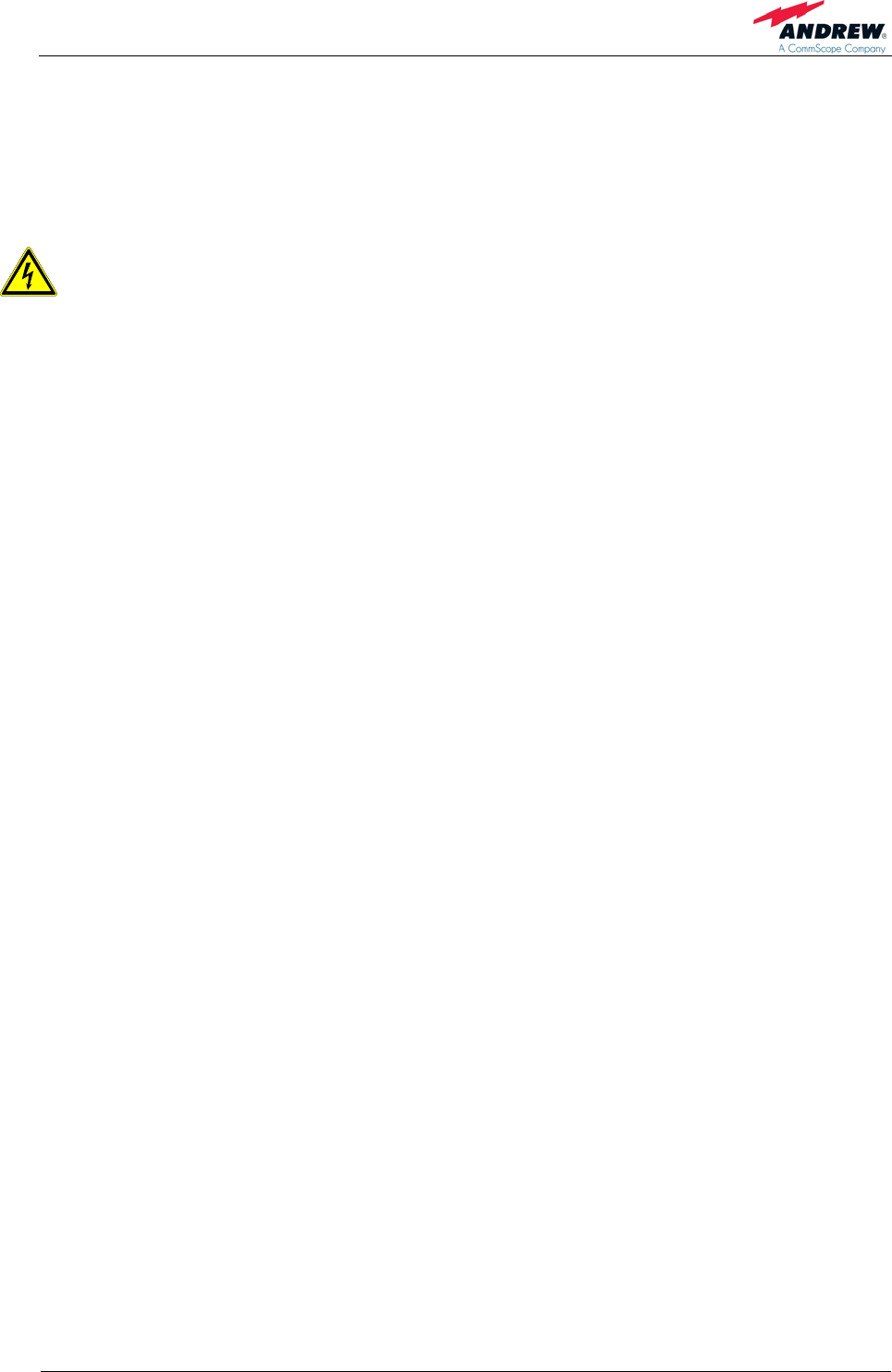
4 Commissioning
Page 25
4.2 ELECTRICAL INSTALLATION
4.2.1 General
Read the health and safety warnings in chapter 1.2 Health and Safety Warnings.
1. This unit contains dangerous voltages. Loss of life, severe personal injury or
property damage can be the result if the instructions contained in this manual are
not followed.
2. It is compulsory to ground the unit before connecting power supply. A grounding
bolt is provided on the cabinet to connect the ground-bonding cable.
3. Although the remote unit is internally protected against overvoltage, it is strongly
recommended to earth the antenna cables close to the antenna connectors of the
remote unit for protection against atmospheric discharge. In areas with strong
lightning it is strongly recommended to insert additional lightning protection.
4. If the mains connector of the remote unit is not easily accessible, a disconnect
device in the mains circuit must be provided within easy reach.
5. Before connecting or disconnecting the mains connector at the remote unit,
ensure that mains supply is disconnected.
6. Make sure that an appropriate circuit breaker and an overcurrent limiting device
are connected between mains and remote unit.
7. A connection of mains supply to a power socket requires the power socket to be
nearby the remote unit.
8. Incorrectly wired connections can destroy electrical and electronic components.
9. To avoid corrosion at the connectors caused by electrochemical processes, the
material of the cable connectors must not cause a higher potential difference than
0.6 V (see electrochemical contact series).
10. It is sufficient to tighten the N-antenna connector hand-screwed. Any use of a tool
(e.g. pair of pliers) might cause damage to the connector and thus lead to
malfunctioning of the remote unit.
11. For unstabilized electric networks which frequently generate spikes, it is advised
to use a voltage limiting device.
12. The unit complies with the surge requirement according to EN 61000-4-5 (fine
protection); however, it is recommended to install an additional medium (via local
supply connection) and/or coarse protection (external surge protection) depending
on the individual application in order to avoid damage caused by overcurrent.
13. Observe the labels on the front panels before connecting or disconnecting any
cables.
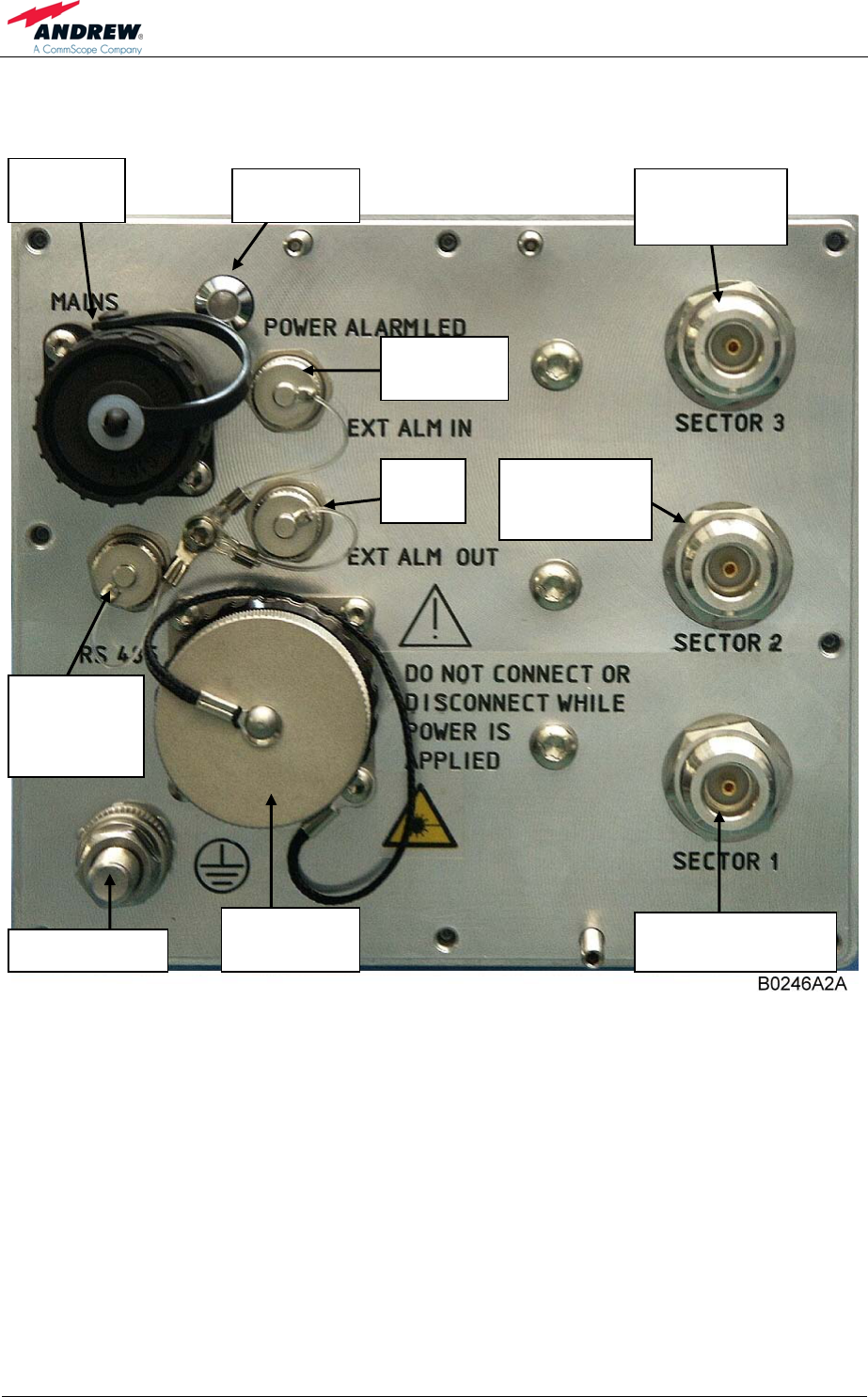
User’s Manual for Remote Unit
ION-M17P/17P/17P
Page 26 M0132AKA_FCC.doc
4.2.2 Connections
figure 4-5 Connector flange of ION-M17P/17P/17P
Alarm
output
Mains
connector
Grounding bolt N-connector mobile
Sector 1
External
alarm input
N-connector
mobile
Sector 3
Optical-fibre
connector
Control
connector
RS485 for
EU
Status LED
N-connector
mobile
Sector 2
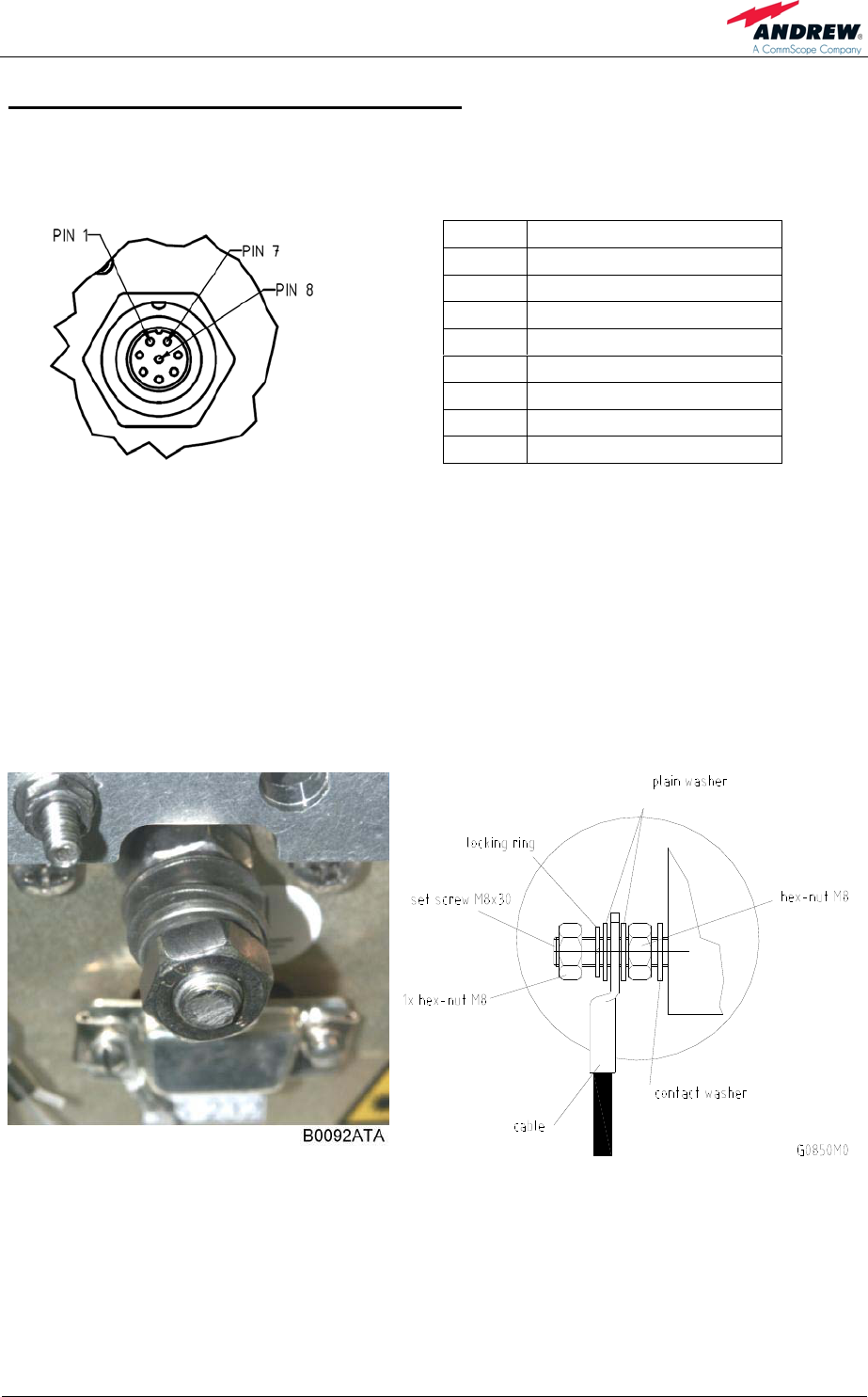
4 Commissioning
Page 27
Control Connector RS232 - Local Interface
This 8-pin male connector (type: Binder Series 712) is primarily to support local
control of the remote unit via RS232 ASCII interface.
PIN Assignment
1 Not connected (n.c.)
2 RS232 Rx
3 RS232 Tx
4 n.c.
5 GND* (RS232)
6 n.c.
7 n.c.
8 n.c.
figure 4-6 RS232 connector table 4-2 RS232 connector, pin assignment
* GND is the abbreviation of Ground
4.2.3 Grounding
Grounding must be carried out. Connect an earth-bonding cable to the grounding
connection provided at the outside of the remote unit (see chapter 4.2.2
Connections). Do not use the grounding connection to connect external devices.
figure 4-7 Grounding bolt with
loosened hex nut figure 4-8 Grounding bolt, schematic view
After loosening the hex nut, connect the earth-bonding cable between the two
washers as illustrated in the figures above. Then, fasten all parts again with the hex
nut.
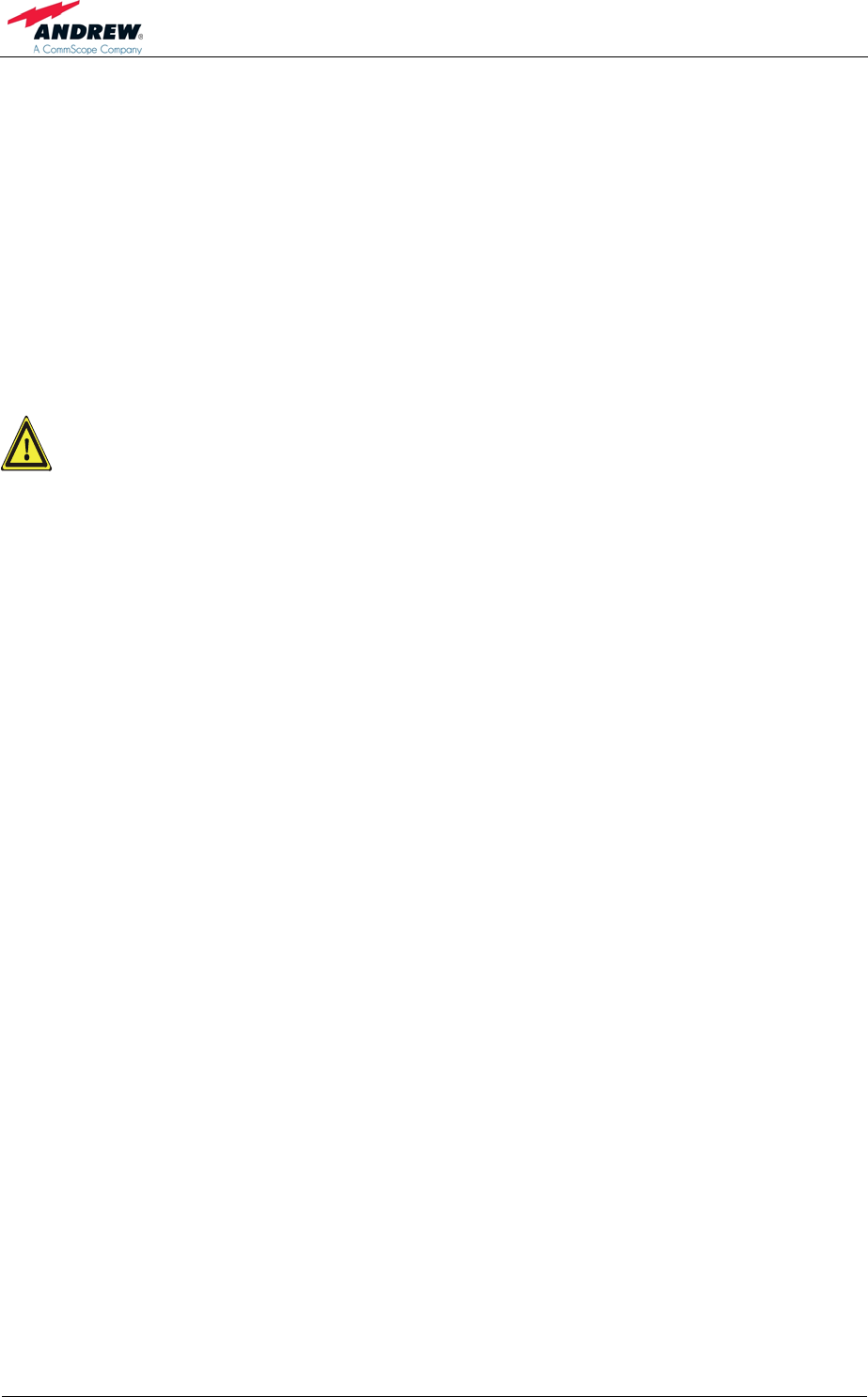
User’s Manual for Remote Unit
ION-M17P/17P/17P
Page 28 M0132AKA_FCC.doc
4.2.4 Connection of the Antenna Cables
The remote unit has N-type antenna connectors. For its location please refer to
chapter 4.2.2 Connections. For mounting the cable connectors, it is recommended to
refer to the corresponding documentation of the connector manufacturer. The
bending radius of the antenna cables must remain within the given specifications.
For the selection of cable and antenna it should be considered that, on the one hand,
a cable with higher loss is less expensive but, on the other hand, it impairs
performance.
It is sufficient to tighten the N-type antenna connectors hand-tight. The use of
a tool (like pliers) may cause damage to the connector and, therefore, lead to
a malfunctioning of the remote unit.
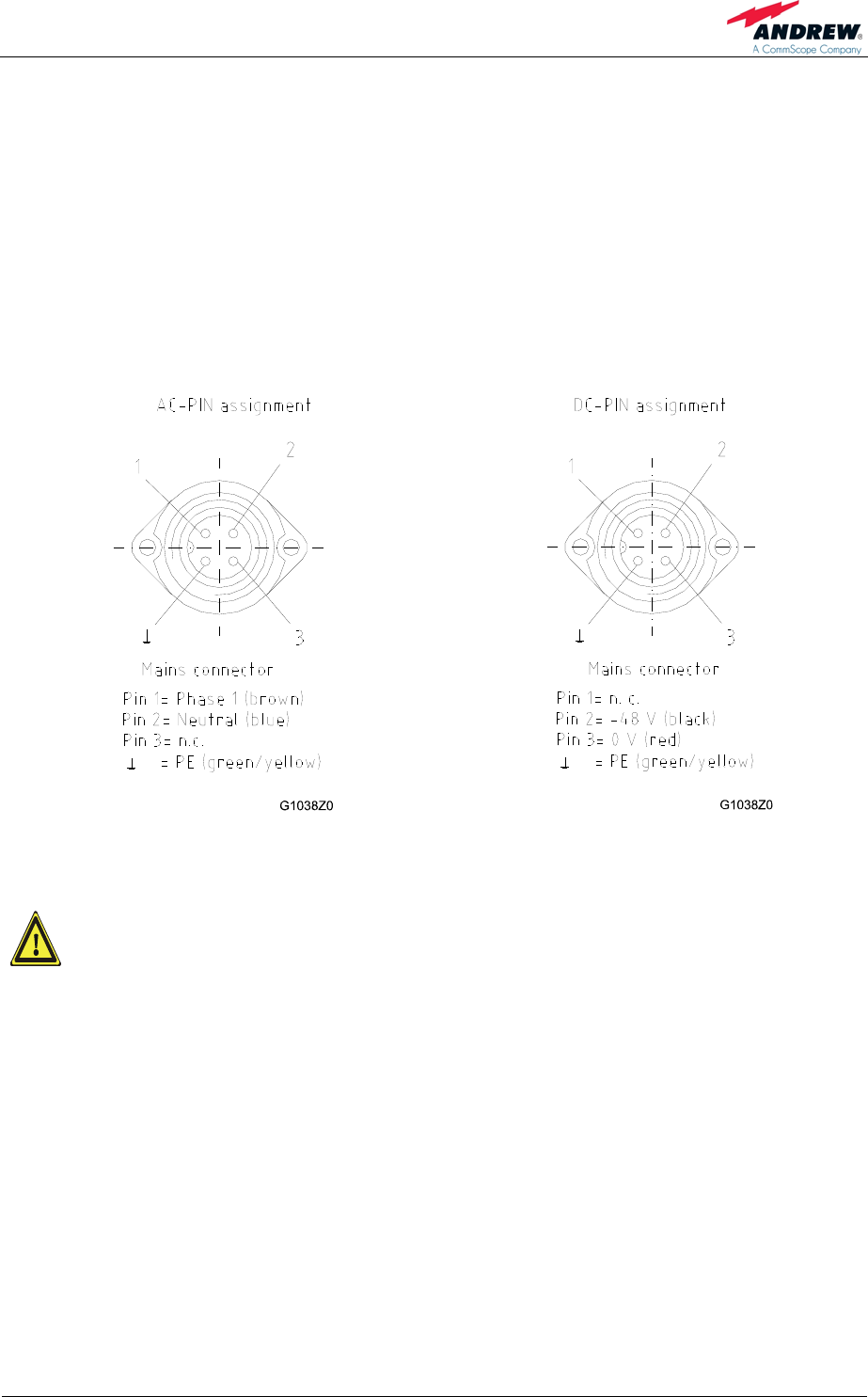
4 Commissioning
Page 29
4.2.5 Power Connection
Before connecting electrical power to the units, the system must be grounded as
described in the previous chapter.
Mains power must be connected at the mains connector of the unit (see chapter
4.2.2 Connections).
The power supply plug is part of the delivery. The correct wiring of the power supply
plug is as follows:
figure 4-9 AC mains plug figure 4-10 DC mains plug
For the AC power supply connection, a minimum cross section of 1.5
mm2 is required and for the DC power supply connection, a minimum
cross section of 2.5 mm2 is required. Each wire must observe the
applicable national regulations regarding loop impedance, voltage drop,
and methods of installation. Make sure to connect the correct voltage to
the unit.
) Note: Do not connect or disconnect the power cord at the mains connector
while power is on. Turn off mains * power before connecting the
power cord at the remote unit, then, engage mains again.
* Mains power must be interruptible with an external mains breaker. For the mains
breaker, observe the following recommendation:
120 Volt / 20 Amp max. or 240 Volt / 16 Amp, single-phase, 50 / 60 Hz AC service is
needed, i.e. the external AC breaker should be 20 Amps max. for 120-Volt service or
16 Amps for 240-Volt service.
For the DC power supply, observe the local regulations of the DC service provider.
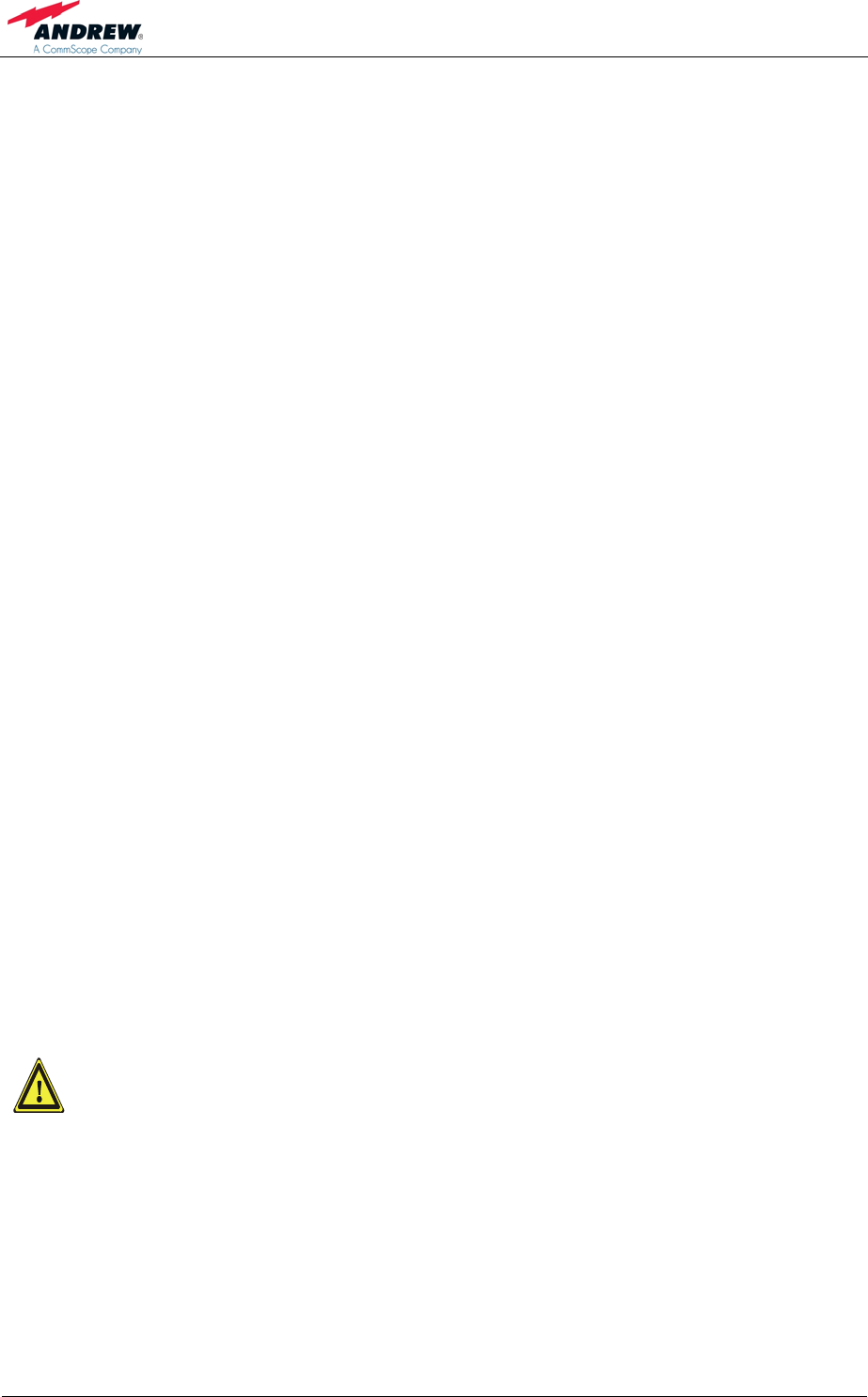
User’s Manual for Remote Unit
ION-M17P/17P/17P
Page 30 M0132AKA_FCC.doc
4.3 OPTICAL-FIBRE-CABLE CONNECTION - RULES
Optical signals are transmitted by use of optical fibres. When connecting these fibres
observe the following instructions.
) Note: Care should be taken when connecting and disconnecting fibre-
optic cables. Scratches and dust significantly affect system
performance and may permanently damage the connector. Always
use protective caps on fibre-optic connectors not in use.
In general, optical fibres do not need special protective measures. However,
protection against environmental influences e.g. rodents and humidity must be
considered.
The optical fibre is a single mode fibre. Type is E9/125 µm with the following
minimum requirements:
Attenuation: <0.36 dB / km @ 1310 nm / <0.26 dB / km @ 1550 nm
Dispersion: <3.5 ps / nm km @ 1310 nm / <18.0 ps / nm km @ 1550 nm
The specified bending radius of the optical fibres must not be exceeded. The pigtails
for the connection between master unit and remote unit must have a sufficient length.
A protection for the feeding into units must be given. The system attenuation of the
optical fibres, including the connectors, must not exceed 10 dB.
System attenuation and attenuation of optical components must be determined. This
can be achieved by measuring attenuation and reflection with an appropriate
measuring instrument. For pigtails, a total value of < 0.4 dB (measured to a reference
plug) can be assumed due to the dead zone of the reflectometer. These
measurements must be made with a sufficient length of optical fibre, at the input and
output of the device which has to be measured.
Fibre-cable connectors have to be of the same type (E2000APC8°) as the
connectors used for the unit. The fibre-optic cables are connected to the optical
transceiver.
Angled connectors are not compatible with straight optical connectors;
non-compatibility of connectors will result in permanent damage to
both connectors.
Before connecting the fibre cables, follow the procedure below to ensure optimized
performance. It is important for these procedures to be carried out with care:
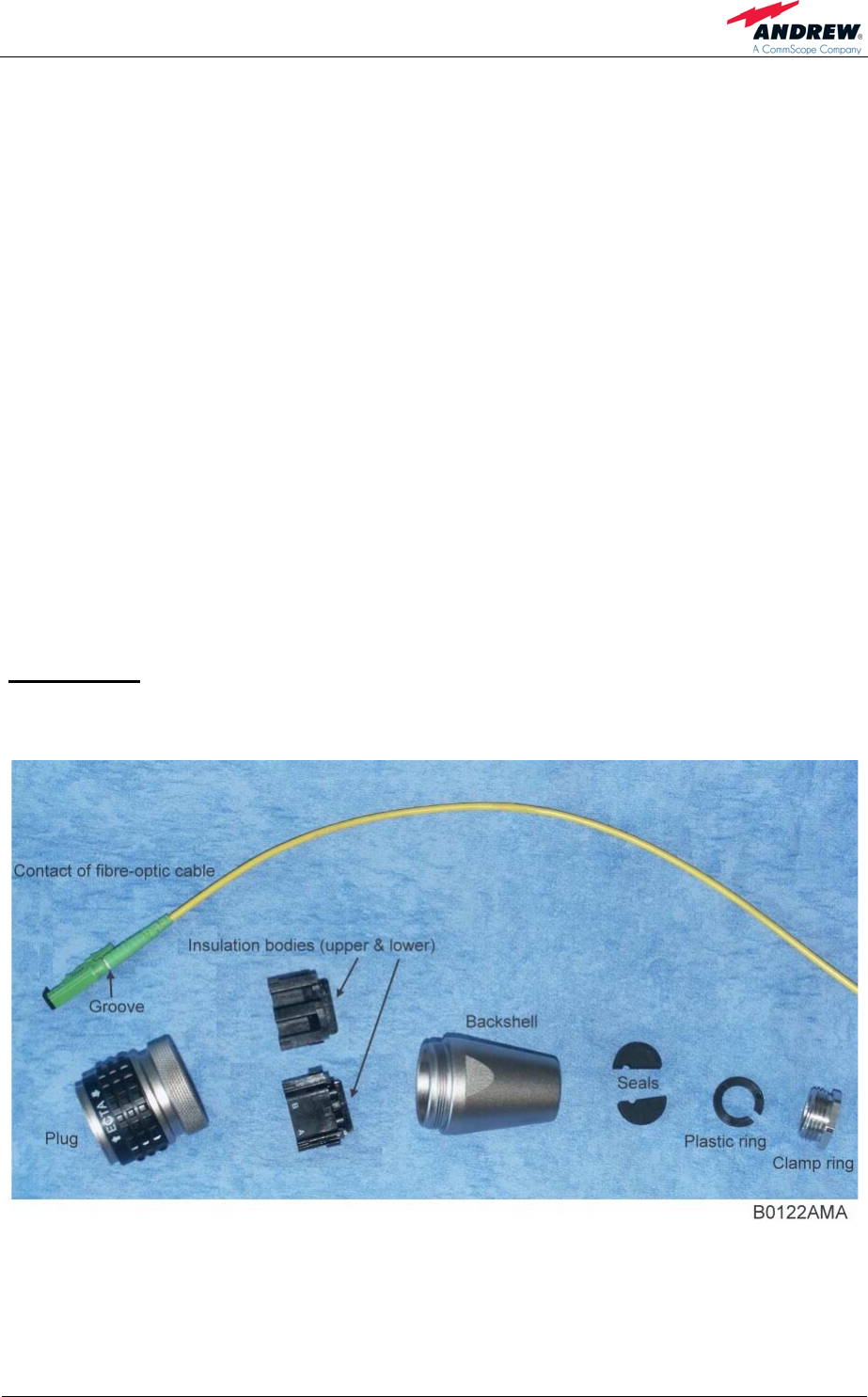
4 Commissioning
Page 31
¾ Remove fibre-optic protective caps.
¾ Do not bend the fibre-optic cable in a tight radius (< 4 cm) as this may cause
cable damage and interrupt transmission.
¾ Using high-grade alcohol and lint-free cotton cleaning swabs, clean the end of
the fibre-optic cable that will be inserted in the optical connectors on the donor
interface box.
¾ Blow out the laser receptacle with clean and dry compressed air to remove
any particulate matter.
¾ Connect the fibre-optic cables by inserting the cable end into the laser
receptacle and aligning the key (on the cable end) with the keyed slot.
¾ Do not use any index-matching gels or fluids of any kind in these connectors.
Gels are intended for laboratory use and attract dirt in the field.
4.3.1 Protective Plug
Connection:
A protective plug is provided for the connection of the fibre-optic cables.
figure 4-11 Protective-plug assembly
) Note: Only high-quality connectors must be used for this type of plug.
Qualified brands are Diamond or Huber & Suhner.
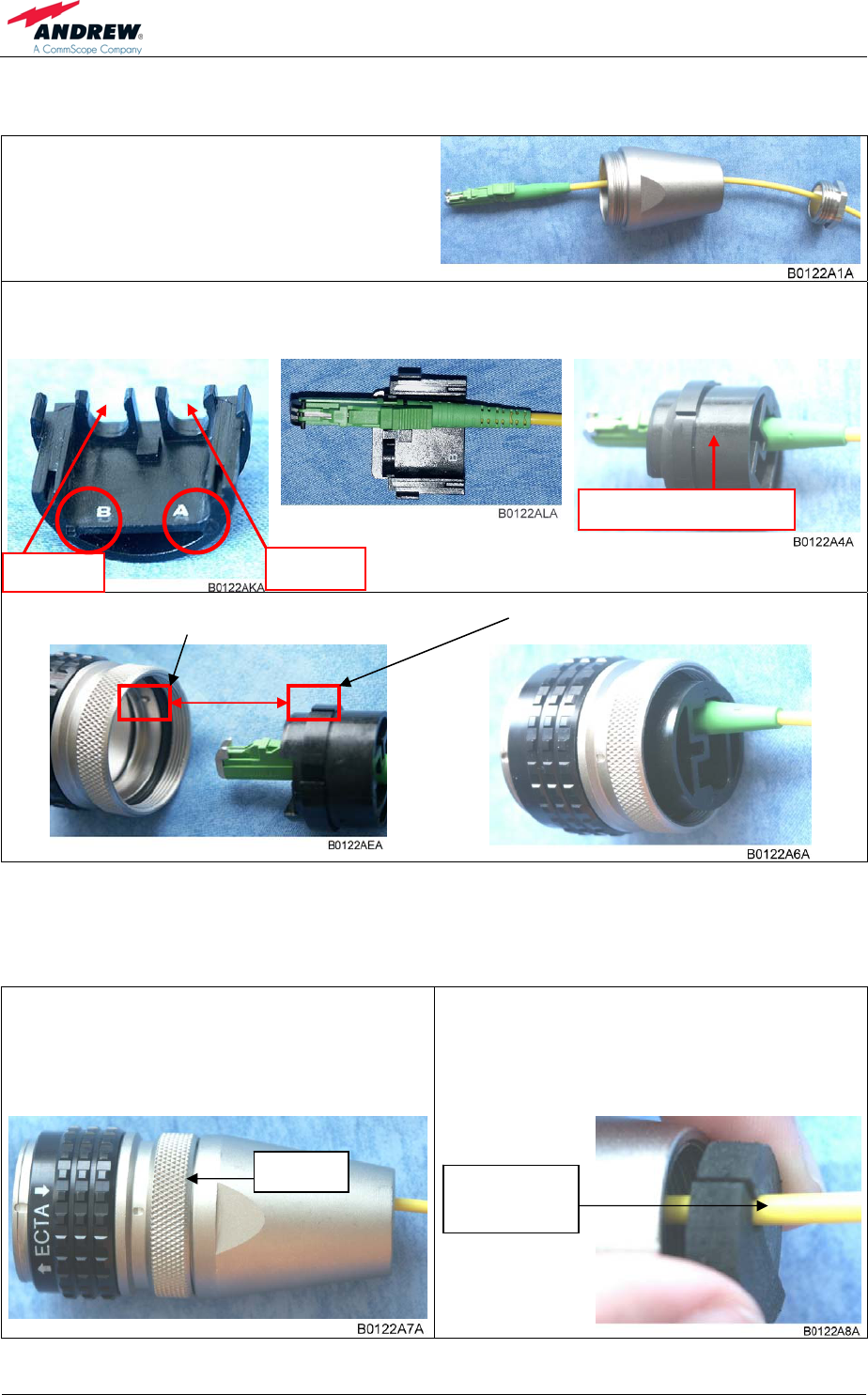
User’s Manual for Remote Unit
ION-M17P/17P/17P
Page 32 M0132AKA_FCC.doc
For plug assembly, observe the following instruction:
1. Pass one or two contacts through the
backshell and the clamp ring.
2. Place the contact(s) on the lower insulation body by pushing the groove of the
contact into the cavity. If there is only one contact, cavity A must be used. *
3. Then, mount the upper insulation body on the lower insulation body. **
4. Bring the insulator into the plug. The narrow groove of the insulator must be fitted
into the stamp of the plug.
* To release the contact for disassembling, push the inner snap to the side and pull the contact out.
** To release upper and lower insulation bodies for disassembling, use a small screwdriver and
carefully open the snap-connections at the left and the right side of the insulator without
damaging them.
5. Fasten the insulator by screwing the
backshell tight onto it. Use a spanner
with opening 32 to screw the
backshell tight (no gap).
6. Place the appropriate seal parts (with
one groove for one contact or two
grooves for two contacts) over the
cable(s) and push them into the
backshell.
Seals with
one groove
No gap
Upper insulation body
Cavity A
Cavity B
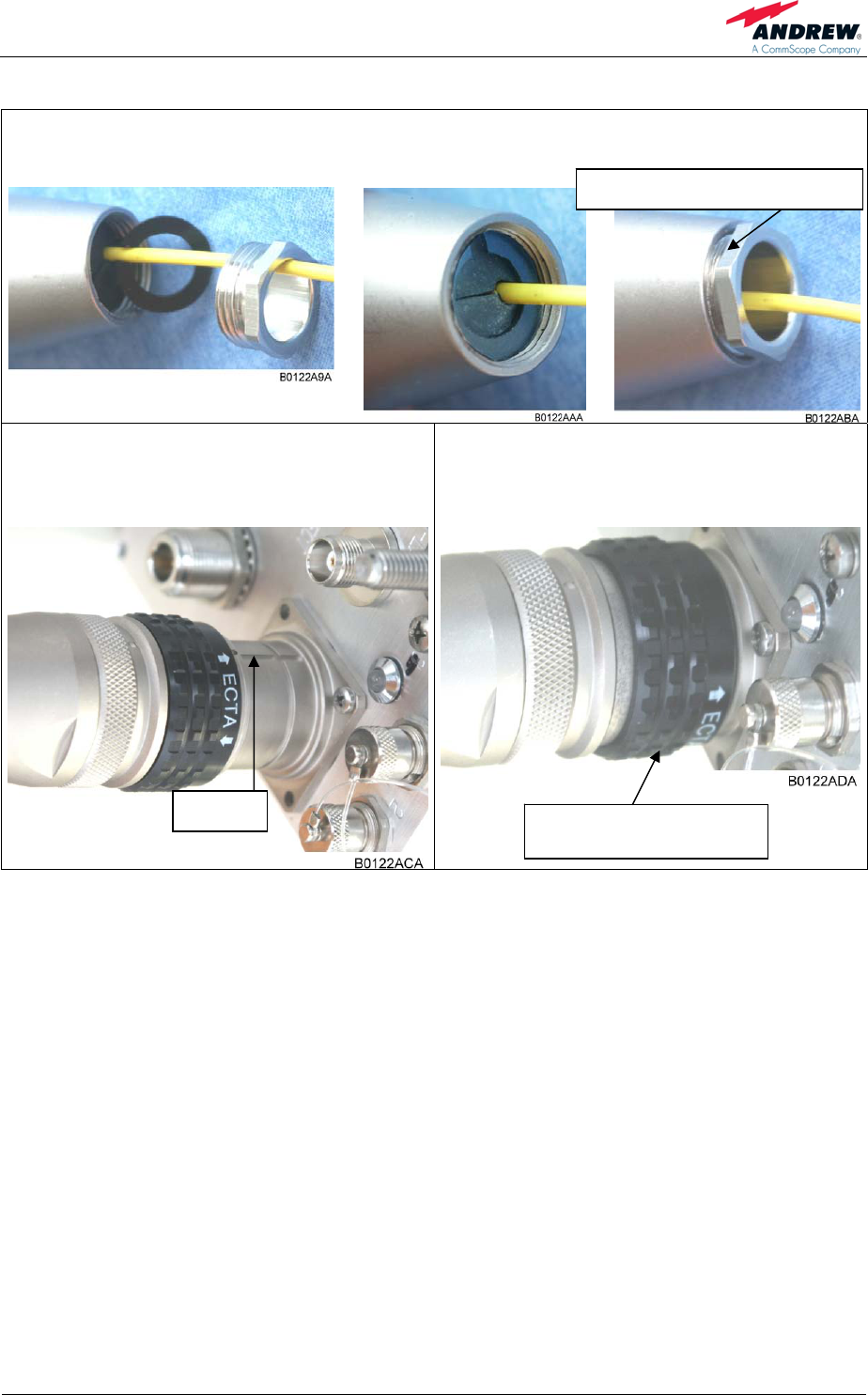
4 Commissioning
Page 33
7. Bring the plastic ring over the cable(s), push it into the backshell and compress
the seals and plastic ring by screwing the clamp ring tight (no gap) using a
spanner with opening 20. ***
8. Connect the plug to the optical-fibre
connector of the remote unit, again by
fitting a stamp on the plug into the
groove of the connector.
9. To lock the connector, push the black
locking ring forward.****
*** For disassembling, release the clamping ring and remove the seals and the plastic ring first.
**** Locking mechanism: The system of locking the plug is based on a “push-pull” mechanism. The
locking ring has to be pushed forward to lock the connector and pulled back to free the
connection.
4.3.2 Protective-Tube Kit
As additional protection for the optical fibres, this connector type can be
supplemented by a special tube kit. To fasten the tube correctly, first unscrew the
clamp ring (if already installed) of the original plug kit.
Then, proceed according to the following instruction:
Groove Push forward to lock, pull
bac
k
to
fr
ee
co
nn
ect
i
o
n
Screw tight until gap is closed
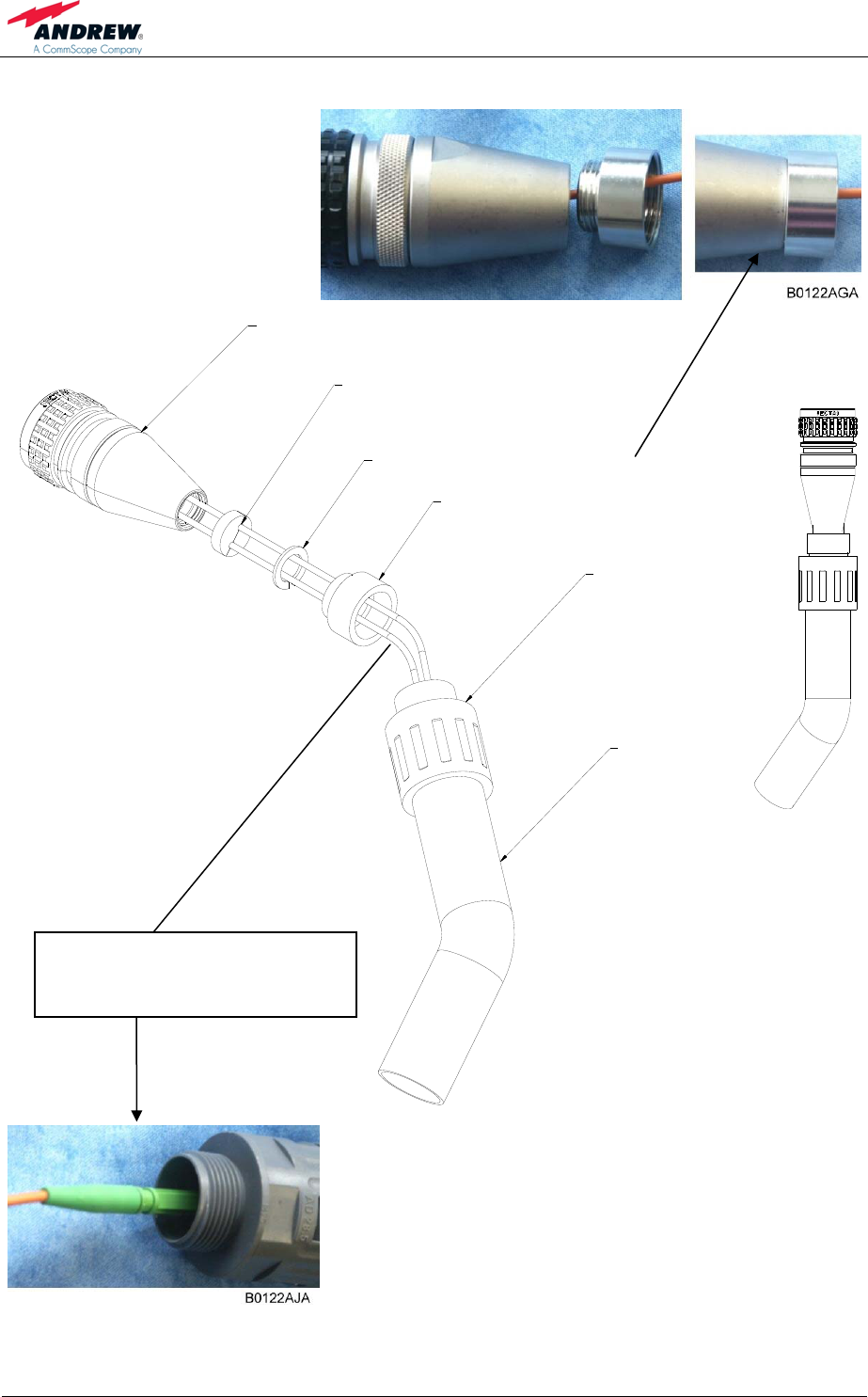
User’s Manual for Remote Unit
ION-M17P/17P/17P
Page 34 M0132AKA_FCC.doc
Scr ew t he r educer t o
t he pr ot ect ive pl ug
backshel l wit hout gap.
Pl ace t he appr opr iat e seal
par t s (wit h) one gr oove f or
one cont act or t wo gr ooves
f or t wo cont act s) over t he
cabl e(s) and push t hem int o
t he backshel l .
G1055M0
pr ot ect ive pl ug
f ibr e cabl e
r educer
coupl ing
pr ot ect ive t ube
pl ast ic r ing
figure 4-12 Tube-kit installation
Push the fibre-optic cable
carefully through the tube until
it comes out at the other end.

4 Commissioning
Page 35
4.4 COMMISSIONING
Read the health and safety warnings in chapter 1.2 Health and Safety Warnings as
well as the description carefully to avoid mistakes and proceed step by step as
described!
• Do not operate the remote unit without terminating the antenna connectors.
The antenna connectors may be terminated by connecting them to their
respective antennas or to a dummy load.
• Only qualified personnel should carry out the electrical, mechanical,
commissioning and maintenance activities that require the unit to be powered
on when open.
• When opening the remote unit do not damage the warranty labels on the
internal devices. The warranty is void if the seals are broken.
• Ensure that all connections have been performed according to chapter 4.2.2
Connections.
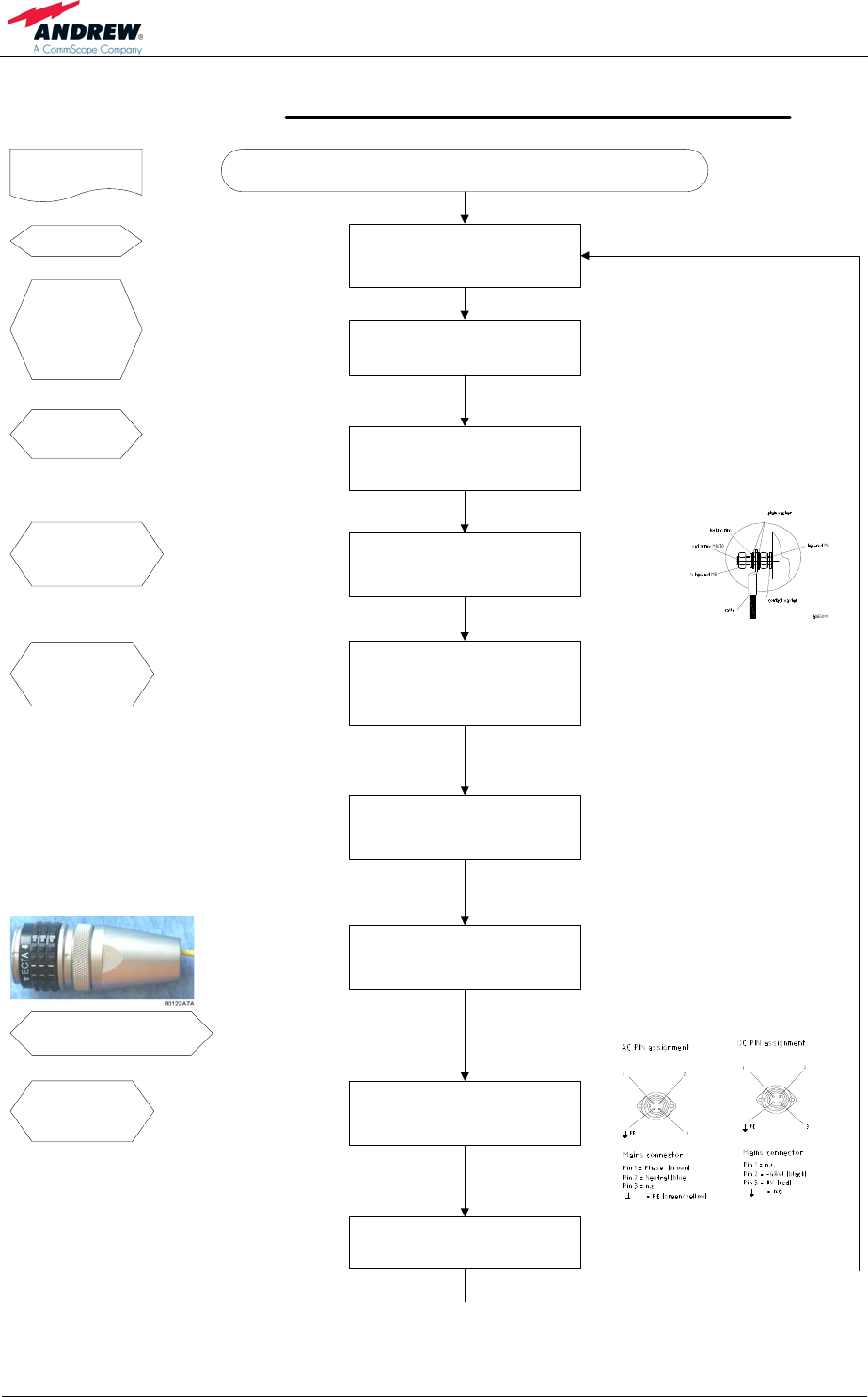
User’s Manual for Remote Unit
ION-M17P/17P/17P
Page 36 M0132AKA_FCC.doc
Commissioning an ION-M Remote Unit
Start
Mechanical installation
Fasten wall or pole mounting kit to wall or
pole.
Manual for Remote
Unit
Electrical connections
Connect grounding cable and
ground the RU.
Mains
Switch mains power on.
Philips
screwdriver
Screw driver
Spanner, size
13 mm
Electrical connections
Connect AC (DC) power to the power
cable. Ensure there is a circuit breaker
between mains and RU.
RF connection
Connect antenna cable to antenna port.
Optical connections
Mount the optical fibre with E2000 APC8°
connector into the connector. Plug the
connector into the RU.
Mechanical installation
Mount RU to mounting kit, ensure suffient
air flow and avoid thermal short circuits.
Preperation
Unpack RU, RU accessories and
mounting kit.
External devices
Connect external devices to the external
in or alarm out connectors, or to the
connecting board inside the RU.
G1055Z
0
G1055Z0
Mounting kit
Spanner, size
13 mm
Drilling
machine
Dowels
Screw driver
Grounding cable
Spanner 13 mm
Mains cable
Connecting kit
Alarm kit
(M-cabinet)
E2000 APC8° connector
Spanner with opening 32
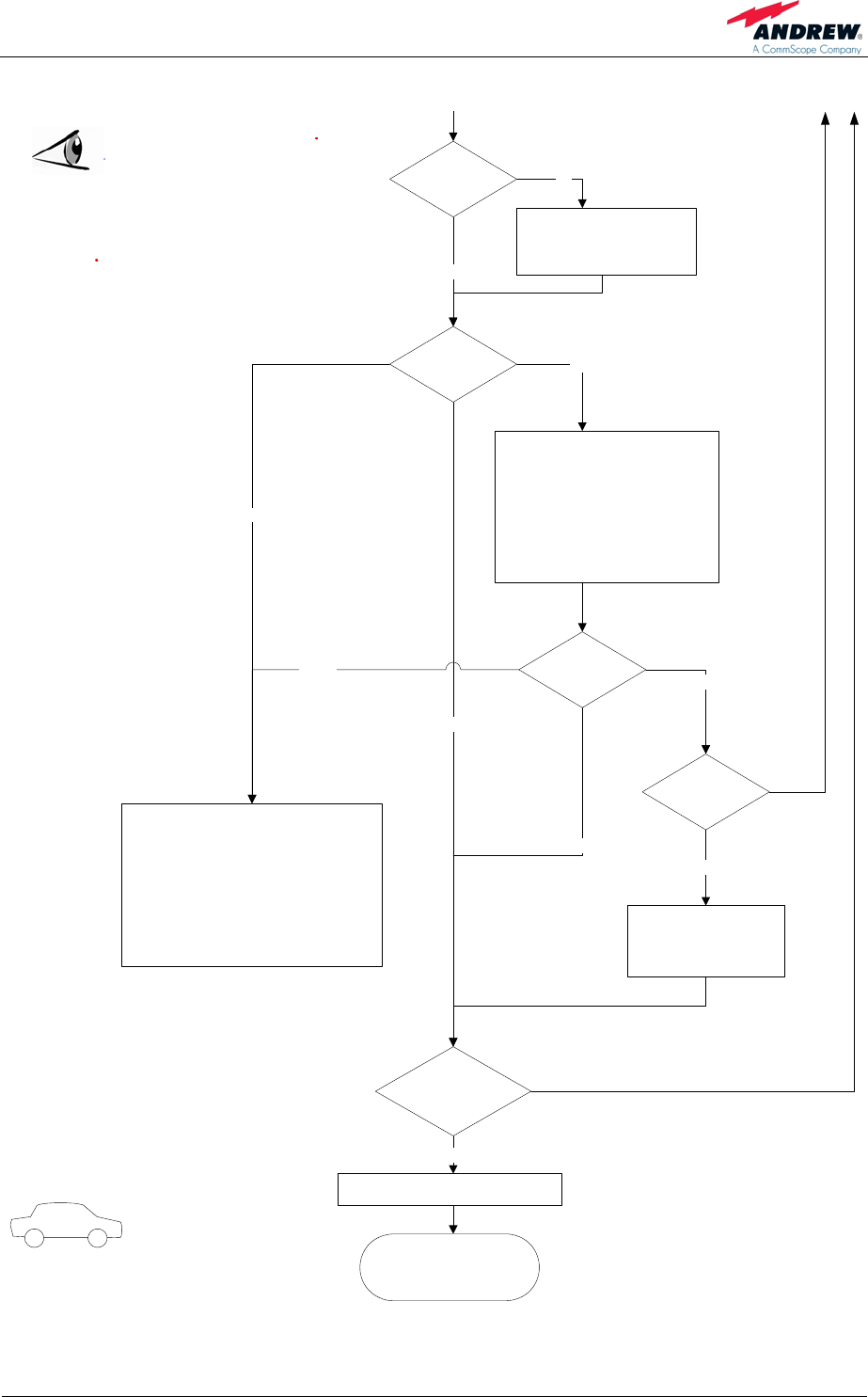
4 Commissioning
Page 37
Output:
All RUs okay.
Go to MU
External error
Close the door (RUs with a door).
Check externally connected devices.
Check fibre loss of optical link.
Check optical connectors.
Clean optical connectors.
Check optical output power of corresponding
OTRx at master unit.
ALC alarm: Decrease DL input power of
affected band.
VSWR alarm: Check antenna and cable.
LED status
Proceed to MU to set up the SW
Orange
Yes
Internal Error
Change power supply (RUs with a
door).
Reduce environmental temperature.
Eliminate thermal short circuit.
Disconnect and connect mains. Fans
should run. If not, replace the fans at
RU.
MU: Change amplifier setting at MU
controller
Red
LED statusYellow
Green
Red
Finished setting up
all RUs?
Green
Spare RU
available?
Yes
Contact customer
service
No
Yes
LED on?
Check power switch inside RU
(RUs with door).
Check mains cabling.
Check mains power.
No
No

User’s Manual for Remote Unit
ION-M17P/17P/17P
Page 38 M0132AKA_FCC.doc
For your notes:

5 Alarms
Page 39
5 ALARMS
5.1 BITE AND ALARMS
The Built-In Test concept comprises the monitoring of the power supplies, the power
amplifiers and the optical interface.
All occurring alarms can be checked via software at the master unit.
5.2 HANDLING OF ALARMS
As soon as the software acknowledges a valid alarm, a message is transmitted to the
master unit.
If the reason for the alarm has been cleared or if the alarm should continue, a new
alarm message will not be repeated. If there was an interruption of at least five
seconds after acknowledgement, a new alarm message will be generated.
5.3 ALARM STATUS
For details refer to the corresponding software documentation of the master unit.
5.4 STATUS LED ALARMS
For local supervision, a status LED on the connector flange of the remote unit gives
an indication of possible reasons for alarms. This table shows possible on-site
measures that could be checked before referring to the master unit alarm list.
Status LED Indication Alarms Possible on-site measures
Green No alarm Æ
Status ok
Door alarm Close the door (RUs with door).
Alarms not directly related to RU:
External alarms Check externally connected devices.
Optical alarm Rx
Check fibre loss of optical link.
Check optical connectors.
Clean optical connectors.
(MU: Check optical output power of
corresponding OTRx at master unit).
Orange
ALC alarm (MU: Decrease DL input power of
affected band).
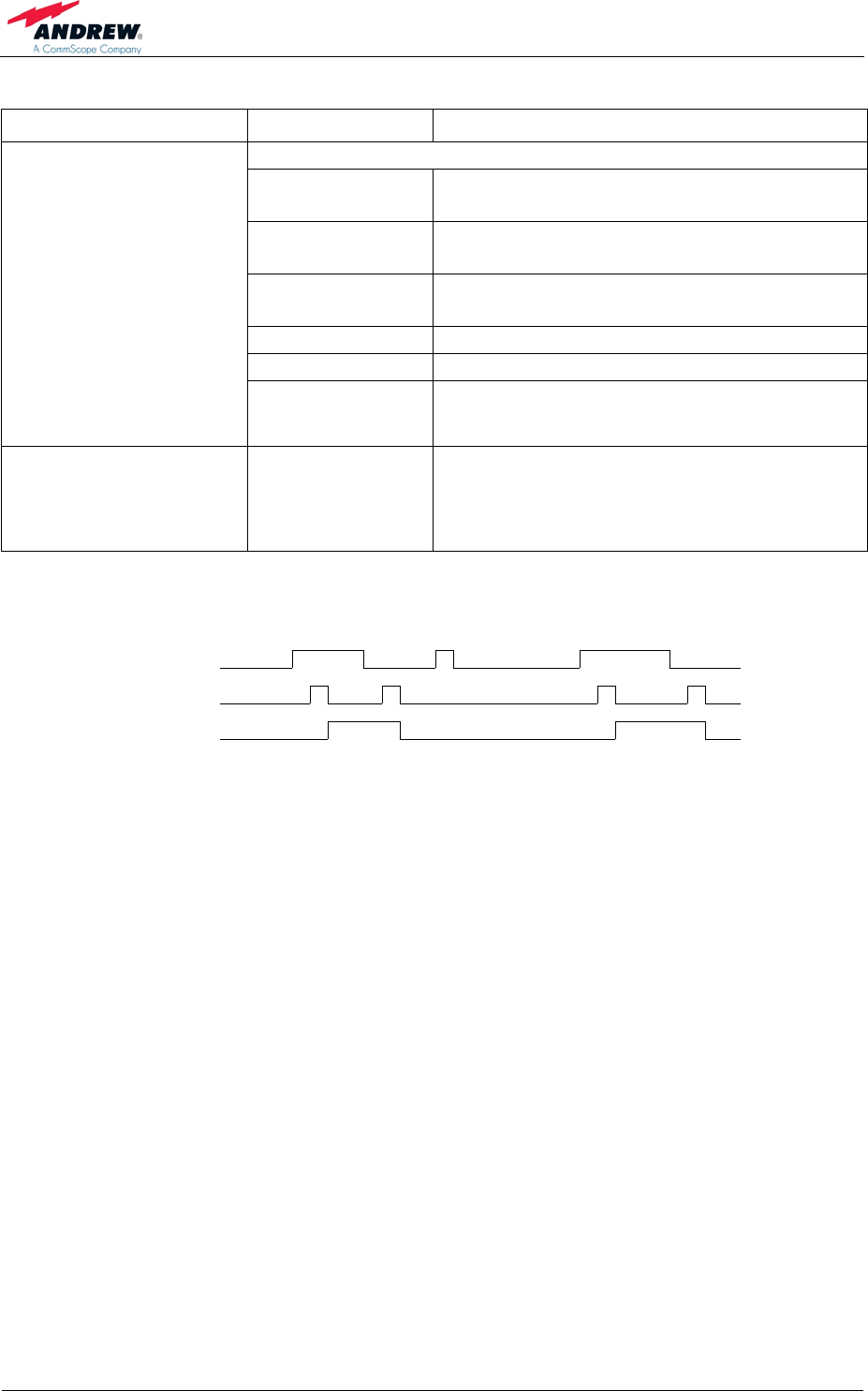
User’s Manual for Remote Unit
ION-M17P/17P/17P
Page 40 M0132AKA_FCC.doc
Status LED Indication Alarms Possible on-site measures
Alarms directly related to RU:
Power 28 V Change power supply (RUs with door).
Replace the affected remote unit.
Temperature Reduce environmental temperature.
Eliminate thermal short circuit.
Fan Disconnect and connect mains. Fans
should run. If not, replace the fans at RU.
I²C Disconnect and connect mains.
Optical alarm Tx -
Red
A
mplifier “Power
Down”
(MU: Change amplifier setting at MU
controller).
Status LED off Mains
Check power switch inside of RU (RUs
with door).
Check mains cabling.
Check mains power.
table 5-1 Status LED alarms
V1651A2
clear
Alarm LED
Alarm transmit
Alarm cause
raise
> 5 s < 5 s
raise
> 5 s
clear
figure 5-1 Alarm triggering
For the position of the status LED see chapter 4.2.2 Connections.
Explicit troubleshooting is available in the MU software, (software manual or WEB
Interface).
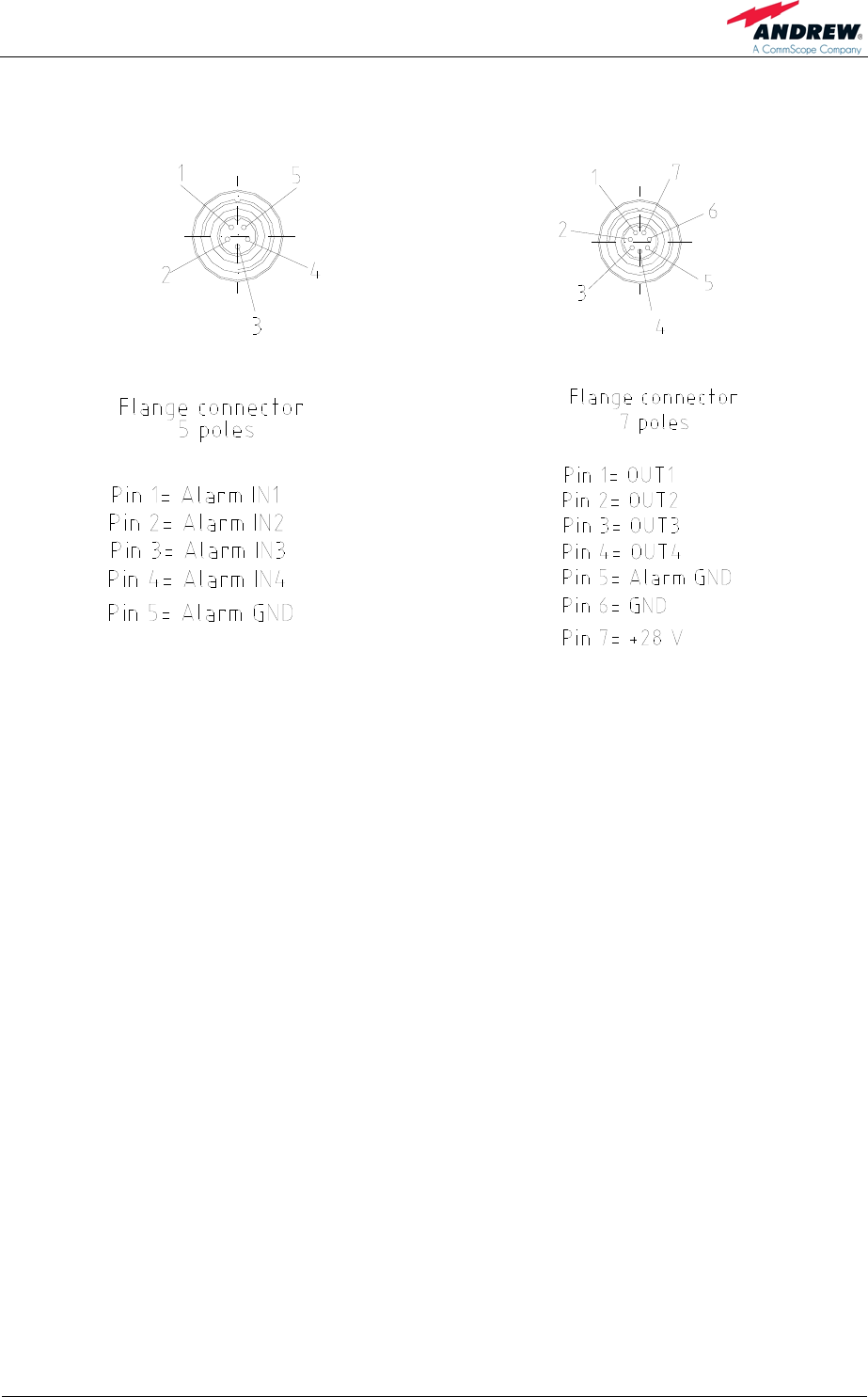
5 Alarms
Page 41
5.5 EXTERNAL ALARM INPUTS AND OUTPUTS
G1038Z0 G1038Z0
figure 5-2 Flange connector, 5 poles figure 5-3 Flange connector, 7 poles
The alarm outputs (open collector output 5 V / 1 mA) are normally low. In case of an
alarm they are high active (5 V). They can be used to monitor alarms with an external
alarm indicator.
The +28 V pin (for its location see figure 5-3 Flange connector, 7 poles) is protected
by a 500 mA thermoswitch. In case of exceeding this current between pin 7 and GND
and/or in case of a failure of the VSWR module, the thermoswitch turns into a high-
resistive status. Then no fuse needs to be replaced. Just wait a few minutes until the
thermoswitch reaches the normal operating temperature again.
) Note: The manufacturer / supplier of this system accepts no liability for
damage caused by equipment connected to external outputs or by
effects from such equipment.
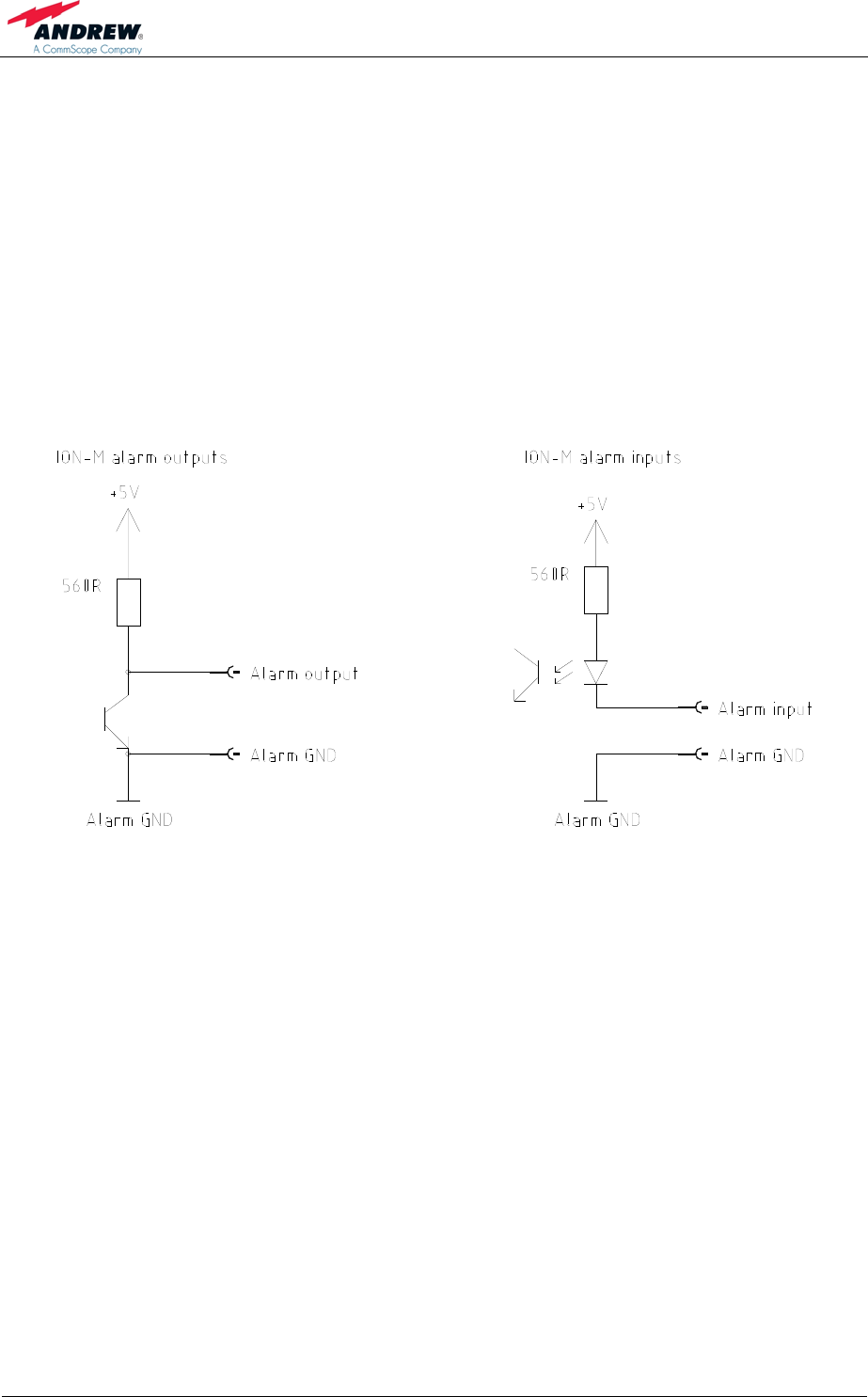
User’s Manual for Remote Unit
ION-M17P/17P/17P
Page 42 M0132AKA_FCC.doc
With the external alarm inputs, it is possible to monitor the status of connected
devices, e.g. a UPS, via software. All alarm inputs are normally high (5 V) without
connection. The polarity (high/ low) can be set via the software at the Master Unit (for
details please see according software manual).
The device to be monitored must be connected so that the alarm contacts will be
closed in case of an alarm (I max = 8 mA). The alarm inputs are potential-free with
common ground.
Subminiature circular connectors series 712 with five and seven contacts, which are
contained in the alarm kit, can be ordered directly from the Binder Connector Group,
the manufacturer, or indirectly from Andrew Wireless Systems. For the designation of
the alarm kit see chapter 7.3 Spare Parts.
V1651A1
figure 5-4 Alarm inputs and outputs, standard
5.6 TROUBLESHOOTING
The status of the remote unit can be checked via the master unit (for details please
refer to the software manual of the Master Controller). Locally, the status can be
checked at the LED, see chapter 5.4 Status LED Alarms.

6 Maintenance
Page 43
6 MAINTENANCE
6.1 GENERAL
Read the health and safety warnings in chapter 1.2 Health and Safety Warnings.
) Note: The remote unit does not require preventative maintenance
measures.
) Note: To prevent malfunctions of the cooling system due to dirt or
pollution, it is recommended to clean the heat sink at regular
intervals. These cleaning intervals depend mainly on the location
of the remote unit and the corresponding degree of pollution.
Maintenance of the ION-M17P/17P/17P should be performed by replacing only
components that are contained in this chapter. In order to maintain warranty, take
care not to damage unintentionally the seals on the modules.
The spare parts list, consequently, contains only units which can be replaced without
tuning or soldering work.
) Note: When sending back the unit, use an appropriate packaging, see
chapter 7.2.2 Environmental and Safety Specifications. We
strongly recommend using the original packaging!
) Note: Defect parts should only be replaced by original parts from the
supplier. All interventions inside the housing are at one’s own risk.
) Note: During maintenance ensure the remote unit has been
disconnected from mains.
) Note: Before disconnecting any cables, label any unlabelled cables to
ensure correct connection.
For most maintenance procedures appropriate tools are required to ensure correct
handling. All these tools can be ordered from the supplier. For screwing procedures
observe that all our screws have a right-hand thread, i.e. for fastening the screws
turn the tool clockwise and for unscrewing them turn it counter-clockwise.
Due to the design of the remote unit the only component recommended to be
replaced is the fan unit. For replacing any other component, please contact the
supplier.
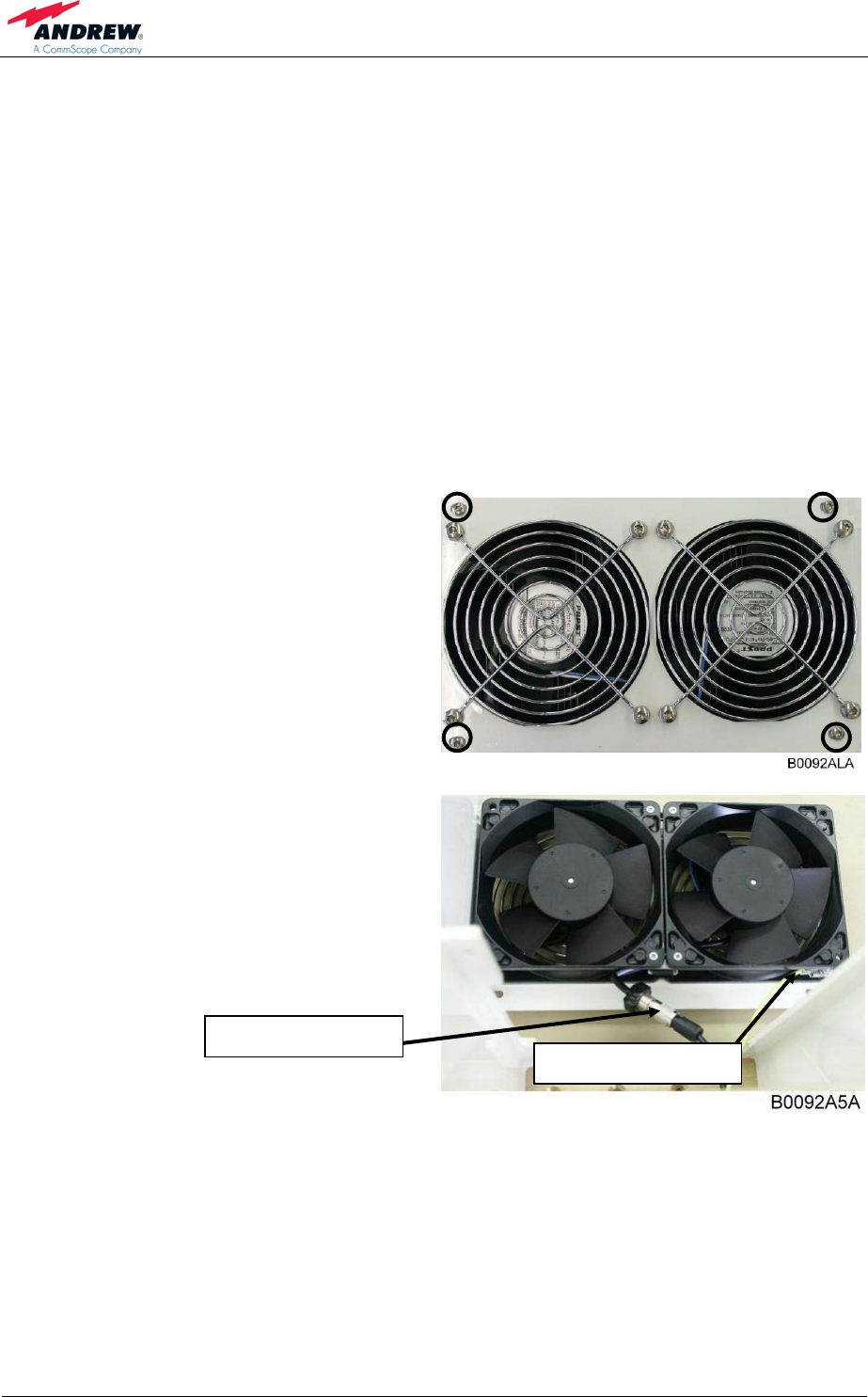
User’s Manual for Remote Unit
ION-M17P/17P/17P
Page 44 M0132AKA_FCC.doc
6.2 REPLACING THE FAN UNIT
Replacement of the fan unit is not required as a preventative measure. Only when an
alarm indicates a malfunctioning of a fan, must the unit be exchanged.
) Note: Please observe that the fan unit can only be replaced as a whole.
Do not remove the fans separately.
Read the health and safety warnings in chapter 1.2 Health and Safety Warnings as
well as the instructions in chapter 6.1 General before starting with the replacement.
1. Switch off the remote unit. Make sure mains is disconnected for the
following replacement procedure. Then, proceed as follows:
2. Loosen the four tallow-drop screws
M4x8 by which the fan plate is
screwed to the cabinet. Remove the
four screws and the corresponding
washers.
3. Remove the fan unit – by putting slight
pressure on the fan plate cover – to a
position that allows access to the fan
connector and the earth-bonding
cable.
4. Unscrew the fan connector and then
disconnect the earth-bonding cable.
) Note: To observe the specified torque of 650 Ncm for an M5 thread, use
an appropriate tool for the following screwing procedures.
Fan-unit connector
Earth-bonding cable
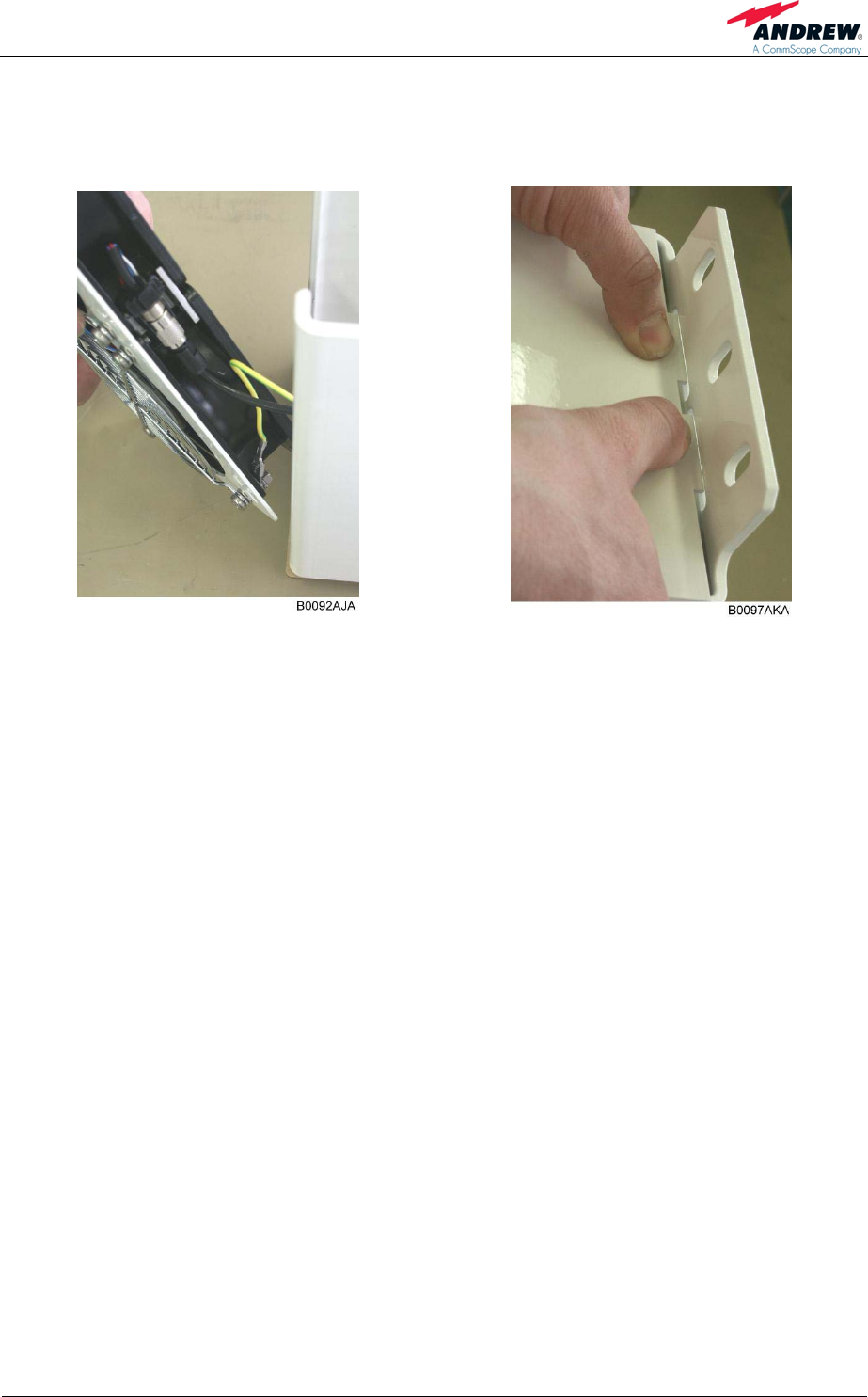
6 Maintenance
Page 45
5. To mount the new fan unit, re-connect the earth-bonding cable and the fan
connector (see step 4). Then, place the fan unit back into its original position and
fix it tight as shown below:
6. Screw the whole fan unit to the cabinet with the four tallow-drop screws M4x8
(see step 2). In order not to exceed the specified torque of 330 Ncm, use an
appropriate tool.
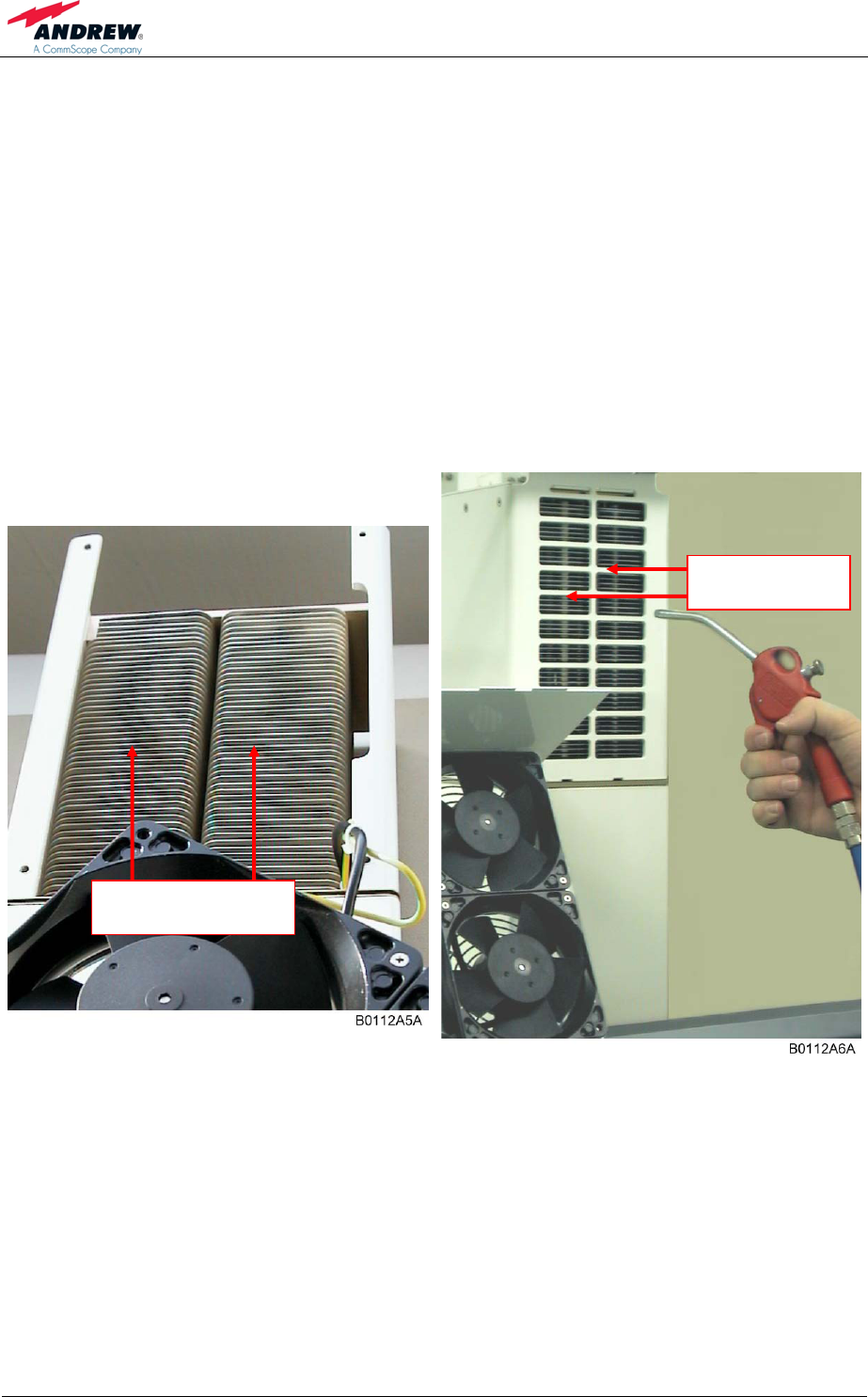
User’s Manual for Remote Unit
ION-M17P/17P/17P
Page 46 M0132AKA_FCC.doc
6.3 CLEANING THE HEAT SINK
) Note: Read the health and safety warnings in chapter 1.2 Health and
Safety Warnings as well as the instructions in chapter 6.1 General
before starting with the replacement procedure. Then, proceed as
follows:
1. Switch off the remote unit. Make sure that mains is disconnected for the following
procedure.
3. Use compressed air (max. 5 bar) to
blow out the heat sink from back to
front:
2. Remove the fan plate with the fan unit
from the remote unit as described in
chapter 6.2 Replacing the Fan Unit,
steps 1 and 2:
4. In case the dirt cannot be blown out
completely and parts of it stick to the
ribs of the heat sink, clean the parts
concerned carefully from the front
using e.g. a brush. Take care that the
material is not scratched or damaged.
5. After cleaning the heat sink, mount the fan unit again according to chapter 6.2
Replacing the Fan Unit, step 6. Then, switch the remote unit back on.
Compressed air
(5
ba
r m
a
x.
)
Brush (not metallic)
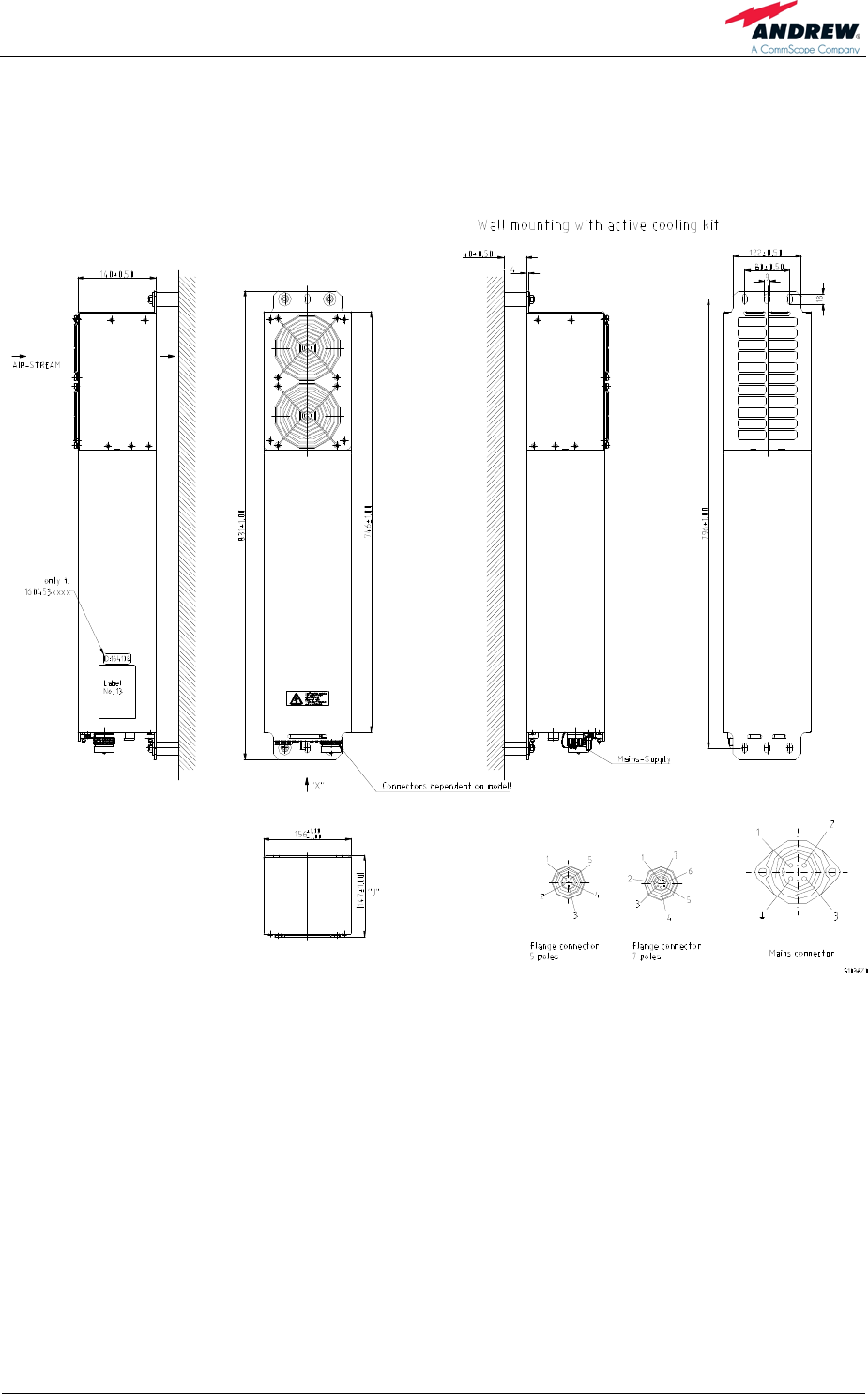
7 Appendix
Page 47
7 APPENDIX
7.1 ILLUSTRATIONS
figure 7-1 Installation drawing

User’s Manual for Remote Unit
ION-M17P/17P/17P
Page 48 M0132AKA_FCC.doc
7.2 SPECIFICATIONS
7.2.1 Electrical Specifications
Detailed ION-M17P/17P/17P– Product Specifications available on request.
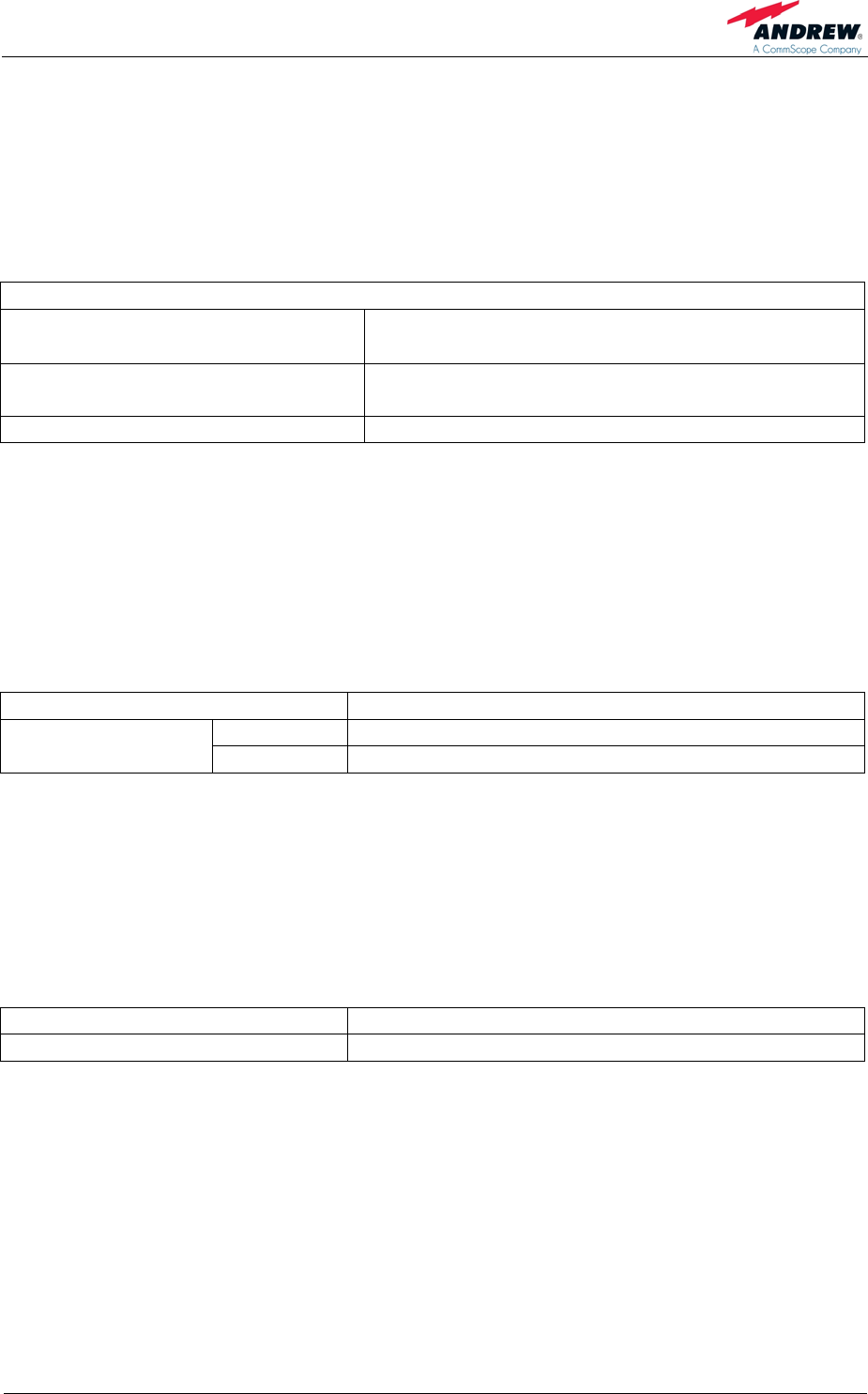
7 Appendix
Page 49
1) PAR 7.5 dB @ 0.1%
2) Note: The noise figure (NF) stated above refers to one Remote Unit (RU) per sector. The
NF system increases with the number of the RUs per sector. It is recommended not
to operate above four RUs per sector. With four RUs per sector, the system NF will
be increased by 6 dB.
All figures are typical values.
System Supervision and Control
Commands RF on/off
External control ports
Alarms Summary, Power supply, Optical UL and DL
failure, Temperature
Supervision Composite output power
All data is subject to change without notice.
7.2.2 Environmental and Safety Specifications
) Note: For detailed information, please refer to the Environmental and
Safety Specifications leaflet of the supplier, related to ETS 300 019
(European Telecommunication Standard).
Operating temperature range -33° C to +50° C
RF part IP67
Ingress protection Fan part IP55
All figures are typical values unless otherwise stated.
All data is subject to change without notice.
7.2.3 Mechanical Specifications
Height, width, depth ** 831 x 156 x 147 mm (32.7 x 6.1 x 5.8 in)
Weight 25 kg (55.1 Ib)
** Spacing required 40 mm (1.58 in) around unit
All data is subject to change without notice.

User’s Manual for Remote Unit
ION-M17P/17P/17P
Page 50 M0132AKA_FCC.doc
7.3 SPARE PARTS
The following lists contain all parts available for the Remote Unit. The configuration of
the delivered unit meets the requirements of the customer and can differ depending
on the state of the delivery.
Maintenance of the ION-M17P/17P/17P should be performed on an FRU (Field
Replaceable Unit) basis only. Do not damage the warranty labels on the
components, as this voids the warranty.
The following spare parts lists only contain units that can be replaced without tuning
or soldering work. To replace an FRU, use the appropriate tools. Replacement tools
may be ordered from the supplier. If any FRU not contained in the following list needs
to be replaced, please contact customer service for additional instructions.
Spare Parts List of the Remote Unit ION-M17P/17P/17P
Designation: ID No: FRU
ION-M17P/17P/17P 7563307
Protective Plug E 2000 7160013 x
Protective Cap E 2000 7158914 x
Fan Protection Kit 7159097 x
Fan Unit 7158254 x
Protective Tube Kit 7162182 x
Manuals for Optical Remote Unit ION-M17P/17P/17P 7609534-00
Accessories
Wall Mounting
Wall-Mounting Kit 7158078
ISO Trafo Kit 115 V Wall Mounting 7159340
ISO Trafo Kit 230 V Wall Mounting 7158322
Connecting Box Kit Wall Mounting 7159613
Overcoat Housing Kit Wall Mounting 7159625
Pole Mounting
Pole-Mounting Kit 7157782
ISO Trafo Kit 115 V Pole Mounting 7159623
ISO Trafo Kit 230 V Pole Mounting 7159621
Connecting Box Kit Pole Mounting 7159612
Overcoat Housing Kit Pole Mounting 7159624
The manufacturer reserves the right to replace the spare parts listed above by
equivalent substitutes.

8 Index
Page 51
8 INDEX
A
Abbreviations.......................................................... 7
About Andrew Solutions ....................................... 11
Address of Andrew Wireless Systems GmbH....... 11
Alarms
Alarm Status .................................................... 39
Bite and Alarms ............................................... 39
External Inputs........................................... 41, 42
Handling of Alarms .......................................... 39
List ................................................................... 42
Outputs ...................................................... 41, 42
RU ................................................................... 42
Status LED....................................................... 39
B
Block Diagram
ION-M17P/17P/17P ......................................... 15
C
Cleaning the Heat Sink......................................... 46
Commissioning
General............................................................ 35
Components
Accessories ..................................................... 17
Fan-Protection Kit ............................................ 17
Interior ............................................................. 16
Connection Rules
Optical-Fibre Cables ........................................ 30
Connections
Antenna ........................................................... 28
Connector Flange ............................................ 26
Optical-Fibre Cable.......................................... 30
Power .............................................................. 29
Contact Addresses ............................................... 12
E
External Inputs
Location ........................................................... 26
F
Flange Connector
5 poles ............................................................. 41
7 poles ............................................................. 41
G
Grounding............................................................. 27
H
Health and Safety Warnings................................... 9
I
Illustrations ........................................................... 47
Installation
Electrical .......................................................... 25
Mechanical ...................................................... 19
M
Maintenance......................................................... 43
Mounting
Fan Protection ................................................. 24
Pole (Outside).................................................. 22
Wall.................................................................. 21
O
Optical-Fibre Connection
Protective Plug ................................................ 31
Protective-Tube Kit .......................................... 33
Outputs
Location ........................................................... 26
P
Pin Assignment
External Alarms ............................................... 41
R
Replacement of Fan Unit...................................... 44
S
Spare Parts .......................................................... 50
Specifications
Electrical .......................................................... 48
Environmental and Safety................................ 49
Mechanical ...................................................... 49
T
Troubleshooting.................................................... 42